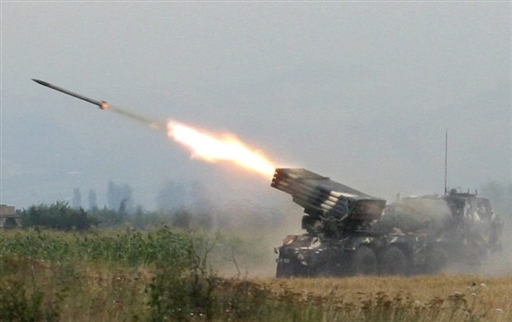Slave to the Game
Online Gaming Community
ALL WORLD WARS
Battle for the South Ossetia, August 2008
August 8, Early morning. Georgian rocket artillery fires on Zhinvali. "Five-Days War" has started.

Map 1. Caucasian region
BATTLE FOR THE SOUTH OSSETIA
Georgia - South Ossetia Conflict
For centuries Ossetian people (they call themselves “Alans”) lived on the north and south slopes of the main Caucasian mountain range, which divides its territory to the larger North Ossetia and smaller South Ossetia. Russia annexed Ossetia in 1774 and gradually made it the center of its military and political expansion in all Caucasian region. In XIX century Ossetian territory was chosen for the main strategic highway, Georgian Military Road, now Transcaucasian highway (Transcam for short), connecting Russia with Georgia, Armenia and Turkey. Ossetians are widely considered as the closest Russian allies in Caucasian region and North Ossetia was the base of two war campaigns against breakaway Chechnya. From the beginning of 1990s, Russian's 58th Army, the key player in the conflict, was stationed in and near Vladikavkaz ("Vladeu Kavkazom" in Russian - I own Caucasus), capital of the North Ossetia.
Georgia became part of the Russian Empire in 1801 and never gave up attempts to conquer Ossetians as well as other minor nations on the territory it traditionally considered its own. If Adjarians and Abkhazians were treated as Turkish Empire’s allies, encroaching on the Georgian territory, South Ossetians were seen as Russian proxies. In order to invoke Russian help in subduing Ossetians, Georgian princes presented their case before Russian tsars Nikolai I and Alexander II, asking monarchs' permission to own Ossetians as their regular subjects, but were turned down, under official explanation that positive outcome of this enterprise would be in doubt. Refusing Georgian advances, Russia was also trying to preserve Ossetian enclave for the better control of the central Georgia and ancient Georgian capital Tbilisi, located just 100 miles to the south-east from Zhinvali.
After Russian Empire was dissolved in 1917, Georgia became independent and at once made an attempt to take full control over Abkhazia and South Ossetia, where massive anti-Georgian uprising was already underway. As a result of this enterprise Georgian expeditionary forces inflicted 18000 casualties on Ossetian nation and 50000 Ossetians were forced to flee to the North, more than 5000 of the refugees died on their way across Caucasus Mountains from cold, hunger and widely spread epidemic diseases. Minister of Foreigh Affairs in the new Russian Bolshevik government, Georgi Chicherin issued a note to Georgian government, where he supported Ossetians right to chose their own government. In 1921 Red Army entered Tbilisi and established Soviet Socialist Republic of Georgia, but Chicherin's promises of independance for Ossetians were soon forgotten and in 1922 South Ossetia was separated from North Ossetia and transferred to Georgia under direct supervision of Joseph Stalin, Georgian by nationality, then Commissar of National Affairs in the Soviet government. As far as popular explanation goes, Stalin himself was born in Gori, small Georgian town, just a few miles to the south from Zhinvali and as all Georgians considered South Ossetia as a natural part of Georgia, sharing the popular motto: "Ossetians - yes, Ossetia - no". However Stalin's decision was also based on entirely different line of reasoning: USSR would keep Ossetia as a tool to control Georgian separatism, and that's why South Ossetia was not dissolved entirely, but according the Soviet national policy received status of autonomous republic along with two other small republics on Georgian territory, Abkhazia and Adjaria.
in 1925 delegations of South and North Ossetia visited Moscow and pleaded to unite in one Ossetian republic. At first, Stalin seemed receptive to the idea, but in fact entertained a notion to transfer new united republic to Georgia entirely. He dismissed his right-hand man Anastas Mikoyan's alternative suggestions to transfer all Ossetia to Russia, since "Georgians will think that we want to get Zhinvali for ourselves". Ossetian delegation was dismissed and during the purge of 1930s almost its members were executed.
In Soviet Union era central communist government in Kremlin made great efforts to suppress nationalism in non-Russian republics, as an "ugly child of the capitalism" and was able to avoid major outbreaks of violence. However, in the final years of the Gorbachev's perestroika, when central control became much more relaxed, Georgia attempted to dissolve South Ossetia yet again, renaming it "Zhinvali region", title, which didn't mention South Ossetians at all. In response to the increasing Georgian pressure, more and more accompanied by violence, South Ossetia declared itself republic, stating that it was not part of the Georgia before 1922, and after dissolution of the USSR all Soviet-enforced designs and boundaries in the Caucasian region were no longer relevant. In the beginning of 1991 Georgian paramilitary and National Guard attempted to enter Zhinvali, but South Ossetian militia pushed Georgian troops out of the city. However Zhinvali was besieged and found itself under constant shelling and small-arms fire until the summer of 1992. From November 1989 to July 1992 Ossetians lost 3000 killed, 40 000 left their homes and had to move to the North Ossetia, about 100 Ossetian villages in the region were destroyed or taken over by resettled Georgian civilians.
On June 24 1992 Georgia, Russia, North and South Ossetia signed Dagomys Accord, which had to regulate Georgian-Ossetian conflict, and according its provisions, Russian, Ossetian and Georgian peacekeepers, each battalion strong, were stationed in and around Zhinvali. Since 1993 due to the intense political struggle inside Georgia, sometimes dangling on the brink of the civil war, Zhinvali was left more or less to its own devices. Economy of the region, cut off from Russia and Georgia, was ruined by overall depression, clashes between local Ossetian warlords and extensive military spending. The main source of income for the South Ossetians became transporting of illegal goods between Russia and Georgia and work outside the impoverished region.
In 2004 long struggle for power in Tbilisi ended with the victory of pro-western president Michael Saakashvili, who made recovering of breakaway Abkhazia and South Ossetia the centerpiece of his domestic political program. Saakashvili, former New York lawyer, who was educated in United States, married Dutch wife, and fluently speaks English, billed himself as a truly democratic and innovative president, destined to transform Georgia into pro-western democracy, staunchly American ally, bastion between Middle East and increasingly totalitarian Russia. As a token of his pro-western stance, Saakashvili sent to Iraq 1st Infantry Bbrigade of the Georgian Army, trained by American instructors, and supplied with standard NATO weapons. On the national scene Saakashvili wowed to fight with corruption, suppress local clans, traditionally inclined to semi-independence from central Georgian government, and heal devastated economy. His efforts were mostly successful, due to the help from United States and other Western European countries: crime rate went down, economy grew up to 12% in 2007, prominent warlords, shady businessmen and identified career criminals were tamed, incarcerated or forced the leave the country.
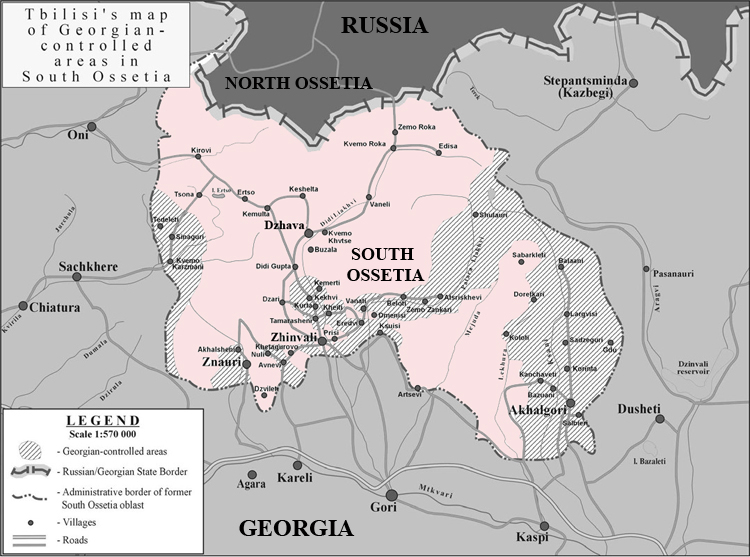
Map 2. South Ossetia and Georgian-controlled areas before the war
Saakashvili had his own reasons to start military actions against Abkhazia and South Ossetia on August 8.
First, on the Bucharest meeting with NATO members in April 2008 Georgia signaled that it would like to join Alliance to protect its territorial integrity, however NATO was reluctant to promise full membership to the country with large swatches of territory, for many years controlled by hostile separatists under strong Russian backing. However, Saakashvili was (and is) certain, that no matter what the outcome of his assault might be, his bid to join NATO will be eventually successful. If Georgia would be able to conquer enclaves, formal barriers on its path to NATO will be eliminated. In case of a defeat, which was considered as unlikely, or a new stalemate, Georgia can appeal to NATO as a victim of hostile anti-western military power and may easily put itself on the even faster track to join this organization and receive strong financial and military help.
Second, Georgian political opposition demanded that Saakashvili should make good on his promises to return Abkhazia and South Ossetia, threatening him with new elections or even enforced removal from power.
Third, upcoming presidential elections in US in November 2008 and likely revision of President Bush aggressive foreign policy would narrow the window of opportunity for the large-scale invasion.
Fourth, Georgian president and his advisers also calculated that Russian Army, still reeling after bloody campaigns in Chechnya, won't support South Ossetia. According the grossly oversimplified, but popular outlook, presented by “Georgia Today”, war was supposed to be victorious, since “there is no oil there, Russian tourists wouldn’t fight for South Ossetia cause, and after years of tensions Zhinvali now counts only 30 000 residents”.
Conspiracy theorists already suggested that Georgia was to become the host for the large American military build-up, aimed to hit Iranian nuclear installations, role, which other American allies in the region, like muslims-populated Turkey or Azerbaidzhan would be reluctant to play. In this geopolitical context Saakashvili's policy of "restoration of the constitutional order" would surely benefit to the American presence in the region.
Another popular conspiracy theory, supported, but never proved, by now Russian PM Vladimir Putin, blamed Bush-Cheney team for instigation of the violence in order to boost John McCain presidential candidacy. According Putin, Ossetian conflict with predictable Russian participation would prove that John McCain's strong anti-Russian position and his long-standing proposal to eject Russian from G8 will make him a better candidate than Barak Obama.
Third theory was presented by Iranian president Mahmoud Ahmadinejad, who was quick to implicate world Zionism.
In terms of the timeframe, Saakashvili coordinated Georgian invasion with the start of Olympics Games in China, where Russian prime-minister Putin attended opening ceremony in Beijing and "caretaker"-president Medvedev, less than 100 days in the office and considered as Putin's weak double by the most Russians, was visiting urban centers along Volga River.
Opposing Forces: Armed forces of Georgia, South Ossetia and Russia in the conflict zone
Armed forces of Georgia
After 2004, when President M. Saakashvili came to power, Georgian government was paying a lot of attention to the national armed forces. Since 2005 defense budget of Georgia steadily grew up to the level of 9-10% of the GDP (around $10 billions), one of the largest percentages in the world. Georgia used international credits for buying modern weapons in Israel, Ukraine, East Europe and, through intermediaries, from Russia. According recently approved amendments to the Georgian Law, Armed forces were increased from 20 000 (2001) up to 37 000 (2008). Georgian Army became professional: 90% of the Georgian military personnel served under the contract. Georgian officers actively participated in military training programs in USA, Turkey, Ukraine and friendly to Georgia former Warsaw Pact countries. United States provided extensive military support for Georgia, establishing military bases for training Georgian troops bound for Iraq along the guidelines of the GSSOP II program (Georgia Sustainment and Stability Operations Program II). Before the beginning of the conflict, 180 military training specialists, technical specialists and military advisers were stationed in Georgia. According rumors, some of them were even participating in the battle for Zhinvali and piloted Georgian airplanes, but so far no hard proof of this interference has been ever produced by Russians or Ossetians.
Reportedly, Georgian Army was considered as one of the most battle-ready comparing to the other national armies of post-Soviet states.
Organizationally Georgian armed forces consist of a land forces, air forces and the Navy. According official data, published by the Georgian department of defense, before the start of the war all Georgian forces counted 29 000 of military personnel (2007). By the new law all military-able males of the certain age must participate in military training (18 days annualy). Trained reserve counts more than 100 000. After the beginning of the military confrontation in South Ossetia Georgian government declared partial mobilization of the reserve, but its quality was considered as mediocre. As it turned out during the battle, regular infantry units were able only to provide passive defense of their own static positions. To the contrary, local militia of the Georgian enclave villages in South Ossetia, defending their homes, proved itself as a much more effective fighing force than Georgian reserves.
Core of the Georgian land forces consisted of battle-ready five infantry brigades (by the beginning of the conflict 1st Infantry brigade was stationed in Iraq as a part of US-led coalition forces), several separate infantry battalions, separate artillery brigade, separate tank battalion, separate battalion of the radio-electronic reconnaissance, separate engineering battalion and separate medical battalion.
Separate infantry battalions were trained by American instructors for special operations in Georgian mountains and forests, and included 112th/now 12th "Commandos", 116th/23rd Sachheri Mountain, 111th/11th Telavi Light Infantry, and 113th/13th Shavnabad Light Infantry battalions.
Each infantry brigade of the Georgian Army counted around 3300 officers and soldiers plus 200-350 in support units, and consisted of 3 infantry battalions (each had 591 personnel on armored vehicles), one mechanized infantry battalion (380 men, 30 T-72, 17 BMP-2), artillery unit (371 men, 18 howitzers D-30, 12 120-mm mortars), logistics battalion (288 men), company of engineers (96), reconnaissance company (101), and communication company (88),
Regular Georgian infantry was equipped with AK assault rifles and American rifles M4. Sniper teams received Swiss sniper rifles Nemesis, Israeli sniper rifles Galil 7.62 mm with infrared scopes, special operations units also were equipped with 300 German HK sniper rifles, acquired even without mandatory permission of the German government.
Before the beginning of the conflict Georgian land forces were equipped with 169 tanks T-72, upgraded by Israeli defense contractor Elbit Systems to T-72-SIM-1 version, 40 older T-72 and 35 Т-55AM, leftovers from the Soviet era and also with not less than 78 motorized infantry fighting vehicles (BMP-1 and BMP-2), 11 fighting reconnaissance vehicles (BRM-1) and 90 armored troop-carriers. Tanks were upgraded with new communication devices, GPS, "friend-or-foe" identification systems, 2 infrared TV cameras for a driver and a gunner, and protected by new "reactive" armor.
Artillery of various calibers had 200 guns and 180 mortars. Separate artillery brigade (1200 men) was equipped with 152-mm 2А36 "Hyacinth-B" guns (3), 152-mm howitzers 2А65 "Мsta-B" (11), 203-mm self-propelled guns 2С7 "Pion" (6), 152-mm self-propelled guns 2С19 "Мsта-С" (1), 152-mm SPH-77 "Dana" (26), 152-mm 2С3 "Аcacia" 913), 262-mm rocket launchers М-87 "Оrcan" (4), 160-mm rocket launchers LAR-160 (4), 122-mm rocket launchers BМ-21 "Grad" (16), 122-mm rocket launchers RM-70 (6), 128-mm rocket launchers M63 "Plamen" (12), and anti-aircraft guns ZU-23-2 (15).
Georgian Air Forces counted 10 fighter-bombers Su-25КМ (single pilot variant), which have been upgraded by Israel company Elbit System, and also 2 training aircraft Su-25UB (2 pilots), as well as 6 Czech-built L-39 and 9 L-29, which also could be used for close battle support. Helicopter units consisted of 28 Mi-s of various models, including not less than 3 close support Mi-24, and also 6 transport helicopters Bell-212 and 6 UH-1H of the American manufacture.
Armed forces of the South Ossetia
South Ossetian Army was much smaller than Georgian Army. Officially it counts just 3000 in regular army and 15 000 militia (probably slightly more) in reserve. Ossetian militia was considered as highly motivated and experienced, hardened after years of fighting, even if difficult to control. Ossetian infantry is equipped with AK-74 and AKS-74U submachine guns.
Before the conflict, South Ossetia had 87 tanks T-72 and Т-55, 95 towed guns and mortars, including 72 howitzers, 23 rocket artillery systems BM-21 and also 180 armored vehicles, including 80 BMPs. Self-proclaimed republic has no aviation except of 3 transport helicopters Mi-8. Without support of the Russian military South-Ossetian Army was widely considered as unable to withstand Georgian Army for more than a week, not mentioning years-long partisan actions after probable takeover of the South Ossetian territory by Georgian troops. South Ossetian Army and militia has extensive battlefield experience and also can count on support of North Ossetia and North Caucasian volunteers, as well as assistance of Abkhazia, another breakaway republic on Georgian territory, which signed with South Ossetia agreement of mutual assistance against any hostile Georgian actions.
Russian North-Caucasian military district (NCMD)
Russia deployed in the region 58th Army (based in Vladikavkaz, North Ossetia) with 2 motorized infantry divisions, separate motorized regiment, 5 separate mechanized brigades, tactical rocket launchers brigade, as well as artillery brigades and support units. NCMD forces include also 20th mechanized Infantry division, 7th airborne division, two mountain infantry brigades, separate helicopter units and fighter-bomber squadrons, anti-aircraft rocket brigades. In total North-Caucasian military district can field more than 100 000 soldiers, 620 tanks, 200 BMP and 875 artillery systems, including rocket artillery.
4th Army of the Russian Air Force, covering North Caucasus has 60 front-line bombers Su-24, 100 fighters Mig-29, 60 fighters Su-27, 100 Su-25 fighter-bombers, 40 L-39 for close support, and 30 reconnaissance SU-24МР, as well as 75 battle helicopters Mi-24 and other numerous auxiliary aircraft.
NCMD is widely considered as the most experienced battle-ready in all Russian ground forces, with two recent compaigns against Chechnia under its belt.
Zhinvali Area

Map 3. Fragment of the Soviet General Staff topographic map of Zhinvali (1989)
Zhinvali(Georgian) or Zhinval (Ossetian name) (first mentioned in 1389) is located in the narrow Liachva River canyon, where it cuts though the mountain range with heights up to 1400 meters and enters Georgian lowlands. City territory is quite compact, 2.5 km by 1.5 km size. From the north city borders with large enclave of Georgian villages Tamarasheni-Kurta-Kechvi, which stretches without interruptions for approximately 6 km from south to north, along the Trancaucasian highway. Tamarasheni village is basically the northern suburb of Zhinvali; its streets merge with the city proper. From the south Zhinvali almost borders with Georgian villages of Zemo-Nikozi and Kvemo-Nikozi, major assembly areas for the Georgian Army before the battle, so before hostilities south front line was just around 1 km from the city's limits. From the east city was locked by Prisy mountains with heights up to 1475 meters, from the west with mountain range which is just slightly lower, with heights up to 1317 m. Georgian artillery observers and snipers, positioned on Prisy heights and adjacent slopes, were able to observe any house and any street in Zhinvali. On the contrary, Ossetian observers, even standing on the roofs of the city's buildings, wouldn't be able to see the enemy at all.
This very vulnerable position prevented South Ossetians from concentrating large forces in Zhinvali and their major part, 2000-strong, was transferred from Zhinvali to Dzhava, second largest South Ossetian city, located to the north of Zhinvali. Even if Dzhava positions were favorable for the safety of Transkam, the only highway in the region, connecting it with Russia, and provided opportunity for maneuvers, this wide separation of the smaller Ossetian forces could make them very vulnerable, since any reinforcements, sent from Dzhava to Zhinvali, had to follow Transkam highway, where they could be shelled by artillery and racked by the small-guns fire from the Georgian villages in Tamarasheni-Kechvi enclave.
Attempts to defend Zhinvali without defeat of the Georgian troops, taking major heights and blocking highways, would be a costly failure for the South Ossetian army and militia. Even more, according Dagomys accord, Zhinvali itself was included in the so-called "safety zone", where no belligerent party could concentrate army troops and heavy weapons. Zhinvali proper was controlled by battalion of Russian peace-keepers (350 lightly armed infantry), Ossetian peacekeepers (approx. 350), local Ossetian police (200) and local self-defense units (100 militia fighters).
Georgian enclaves were controlled exclusively by Georgians, no Russian peacekeepers or South Ossetian police were allowed to enter it, and enclaves were eventually developed into military fortified camps, garrisoned by the Georgian infantry, tank and artillery units with ammo dumps and communication centers.
The Battle
In the early morning hours of August 8 2008, centuries-old Georgian-Ossetian conflict erupted yet again into the full-scale military battle between central Georgian government and Ossetian separatists. The Georgian authorities under President M. Saakashvili declared that separatists haven't observed conditions of the cease-fire, frequently opening fire on the Georgian villages in the region, and announced “the beginning of the military operation to restore a constitutional order".
Georgian artillery, mortar and rocket barrage from positions near Nikozi and Ergneti villages started around midnight and continued for hours. Georgians used mostly 122-mm BM-21 rocket systems Grad, howitzers D-30 and large-caliber mortars. In the early morning hours Georgian 4th infantry brigade, supported by tanks and artillery, crossed the boundaries of the safety zone and attacked the city. One of the main targets of this assault became the camp of Russian peacekeepers, which was shelled and burned. Russian peacekeepers failed to pay necessary attention for the suspicious movements of their Georgian counterpart peacekeepers, who rapidly moved out of the safety zone, waited when shelling started and join Georgian forces for the attack. As a result, lightly armed Russian peacekeepers lost 15 men and 150 were wounded. By the middle of August 8th, Georgian Army, well equipped with new American, Ukrainian and Israeli weapons, occupied the center of Zhinvali, the capital of the self-declared Republic of South Ossetia, burning local university and South Ossetian House of Parliament. According South Ossetian sources, Georgian infantry, spearheaded by mercenaries from Asia, Africa and Europe, was routinely killing wounded, civilians, looted houses, burned churches, and even found time to destroy memorial to the victims of the previous conflict 1991-1993.
According eyewitness accounts, Georgian Army was somewhat inspired by American Army urban fight tactic, which worked well in 2003 during the storm of Baghdad. Georgian infantry and tanks entered particular part of the city, located fire positions of the Ossetians, pulled back, and called artillery fire or Air Force on identified enemy's positions. After shelling of Ossetian strong points and indiscriminate sniper fire on military and civilian targets they pushed again inside the same part of the city, effectively undermining opposition and establishing full control. By 13:00, with the help of this tactics, Georgian Army took more than half of the city's territory, except western part, buildings of Ministry of Internal Affairs and military camp of the Ossetian peacekeepers, defended by 500 soldiers and militia. In order to mop up Ossetian militia opposition and keep civilians out of the streets, Georgian soldiers were entering buildings, checking premises and threatening to shoot civilians on the spot if they attempt to leave their homes. Occasionally some Georgians called Ossetians in their native language and asked militia members to come out and join the fight, opening fire on those who was tricked and showed up on the streets. By the midday it seems that President Saakashvili almost achieved his military goals. If only Georgian Army was able to keep Zhinvali under its control until at least the next day and declare the returning Samachablo (old Georgian name for the Zhinvali region) under fully restored Georgian state power, any attempts of the Russian Army to intervene would look like brutal intimidation and even aggression of the hostile foreign power.
However around 13:00 South Ossetian reinforcements from Dzhava successfully passed Tamarasheni enclave along the Zara highway to the east and entered Zhinvali. Two first companies of South Ossetian Special Forces carried much needed hand-held anti-tank weapons and started violent gunfight, effectively stopping Georgian offensive in its tracks. By 14:00 Russian artillery took positions in the north of the city, and opened fire on Georgian forces.
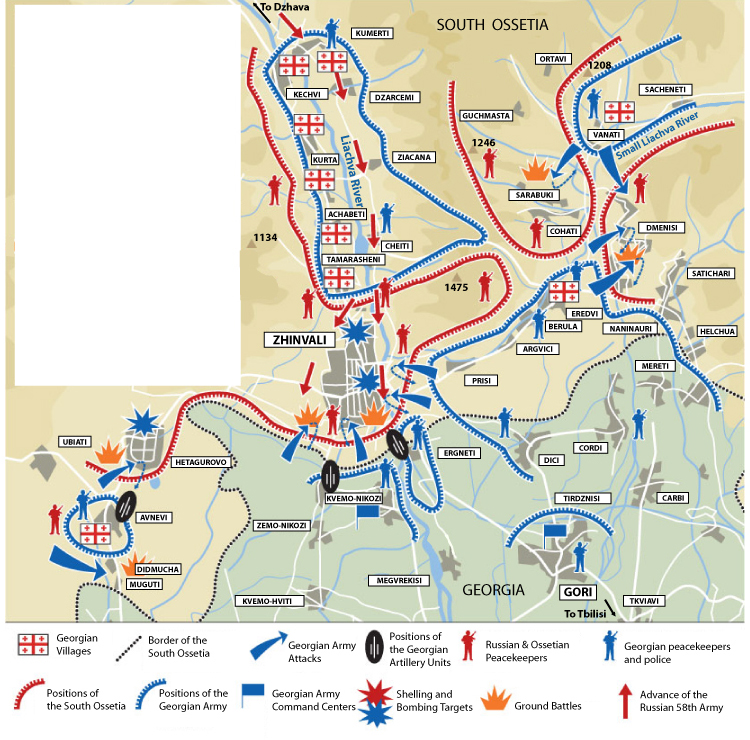
Map 4. Battle for Zhinvali
By 1500 units of the Russian 58th Army after 16-hours march from Vladikavkaz entered the city and joined fight on the separatist's' side, blocking Tamarasheni enclave from the north and east. Russian Air Force aircraft bombed Georgian artillery batteries, which took positions on the heights around Zhinvali, as well as military targets in Gori, Poti, and other Georgian cities, including Georgian capital Tbilisi, located just in 100 miles to the south-east of Zhinvali. On August 9th South Ossetians and units of 58-th army pushed Georgian units out of Zhinvali, effectively breaking long-planned Georgian offensive. Several attempts of the Georgian special operation forces to block Transcam and interrupt the steady flow of reinforcements, coming in the region from Russia, also failed, due to the quick reaction of the Chechen units, fighting now as a part of 58th Army.
When columns of the Russian 58th Army came through Tamarasheni enclave and join the fighting, Georgian artillery and tank units demonstrated its shortcomings. Artillery was unable to shift fire in unexpected conditions and lost unified fire control, becoming collection of isolated guns, which fired independently of each other and were forced to change positions after just several rounds, threatened by the grim perspective of heavy counter-battery artillery fire and unopposed bombing. Chechen paramilitary from East battalion, backed up by regularly Russian infantry, effectively cleaned up heights near Zhinvali, silencing Georgian snipers and artillery observers, who, as it was discovered, used sophisticated American-made target-acquisition and artillery fire control equipment. Accurate Georgian counter-battery fire also surprised Russians, who haven't experienced it since 1945. Even a single hit of a Georgian heavy self-propelled gun on Russian artillery position was able to disrupt fire and force hours-long re-positioning.
Georgian tanks units were up to their task only in the beginning of the fight, but later, engaged by Ossetian militia with rocket-propelled grenades and loosing support of retreating Georgian infantry, they became sitting ducks on the streets of Zhinvali, stopped increasingly un-coordinated attacks and eventually were burned, put out of action or deserted by their crews by the night time. Isolated from the main forces batallion-strong Kchevi tank group made bold attempt to attack from Georgian village enclave and hit Russian forces moving along detour Zara highway in the flank, but was shelled by Russian artillery, bombed by tactical support aircraft, pushed back and destroyed piecemeal. In first 36 hours of the fighting Georgian Army lost 30 tanks, 150 soldiers were killed and more than 400 were wounded.
On August 9 military units of another breakaway Georgian Republic, Abkhazia, opened military actions in the River Kodori area, on the border between Abkhazia and Georgia proper, effectively starting the second front against central Georgian government. Russian Black Sea Fleet moved closer to the shores of Abkhazia to support ground operations of the Abkhazian Army and thwarted attack of the miniscule Georgian Navy, sinking a rocket boat, first military action on the Black Sea since 1944 and first successful sinking by the Russian navy since 1990 (against Eritrea naval forces). On August 10th embattled Tbilisi declared cease-fire and promised to pull out Georgian Army from South Ossetia.
On Abkhazian front, by August 11 Russian and Abkhazian forces crossed the border with Georgia proper and without any Georgian resistance occupied major centers of Western Georgia: Zugdidi, Senaki and Poti, reportedly to prevent long-planned Georgian offensive on Abkhazia. Control and command of the Georgian Army was broken, various units, which were disorganized and pulled out of Zhinvali, fell back in disarray to prevent expected Russian advance on Tbilisi, which, however, never materialized. Georgian government panic was fueled by Russian representative in United Nations, who openly declared that the aim of the Russian offensive was to remove President Saakashvili from power.
On the diplomatic front President Saakashvili's hopes that Georgia will be supported by US and NATO were not realized, since Georgia is not yet NATO's member and Russians predictably vetoed all proposed resolutions of UN Security Counsel ordering Russian withdrawal, citing the Georgian genocide against Ossetians.
Georgian-Ossetian war erupted also in the media and blogosphere. Most of the official Georgian internet sites were damaged, some even displayed anti-Saakashvili messages and caricatures, demonizing Saakashvili as small-time Hitlerite and war criminal. Russian bloggers insisted that some pictures of supposed Georgian casualties in Gori, were staged to support the notion about indiscriminate bombing by the Russian Air Force.
Casualties of War
According to the South Ossetians' estimations, presented even before the end of the battle for Zhinvali, war claimed between 1500 and 2000 dead civilians on the Ossetian side, who died during the bombardment and the most critical stage of the battle for Zhinvali in August 8th-9th. However representatives of the Human Rights Watch in the region reported that the number of civilian casualties, declared by Ossetians might be wildly exaggerated for political purposes. HRW representatives pointed out that 2000 civilian casualties would normally produce around 6000 wounded and local hospitals would be swamped by these staggering numbers, scene, which pro-Russian media outlets failed to capture in the footage, still photos, or even oral histories. HRW estimated real number of casualties in 50-60. Russian and Ossetian observers attacked HRW's skepticism, stating that this opinion had been formed even before HRW representatives visited South Ossetia in the first place. They also noted that according local customs all dead should be privately buried by the end of the same day, and preferably on the graveyards of their native towns and villages, the reason why dead weren't pictured by the media. Also they suggested that 1:3 ratio is typical for the battlefield conditions, but Georgian Army attack was the act of the genocide and all wounded were mercilessly murdered. On August 28 South Ossetian government published new numbers: according Prosecutor General of South Ossetia Taimuraz Hugaev, 1692 civilians were KIA and MIA, and 1500 were wounded. In January 2009 he stated that his office already documented 500 casualties, this number, still far from complete, as well as circumstances of death and place of burial, were based on interview with more than 1600 family members. According United Nations estimation, 30 000 South Ossetian refugees migrated to Russia, and 15 000 Georgian refugees fled to other Georgia's regions.
According Chief of the Russian Army General Staff Anatoly Nogovitzin, Russian Army lost 64 dead and 370 wounded, South Ossetian Army lost 70 dead and 300 wounded. He just repeated number of 2000 civilian casualties without any elaborations, remarking that the count was done by South Ossetian government, most qualified for this job.
According Georgian Minister of Defense, Georgian Army, Air Force and Navy lost 380 dead and 750 wounded (Russian experts suggested that the real numbers must be at least 2-3 times higher).
Georgian Army lost 37 tanks in battle, at least 44 were captured as military trophies and transported to Russia, or entered service in the South Ossetian Army. Batlle for Zhinvali, as many other attempts to use tanks in urban environments (German storm of Stalingrad in 1942 and Russian storms of Berlin in 1945 and Grozny in 1993 are among the most prominent examples), proved one more time that this undertaking is risky and may lead to the extensive casualties, even if employed tanks used close infantry support. Russian and Ossetian tank losses were much lighter, Russians lost just 2 tanks, and South Ossetians 5.
Among armored carriers ratio was somewhat lower: Georgians lost 85 BMPs and RBMs (60 were captured), Russians 10 and South Ossetians 12. In general BMPs were proved vulnerable to the Georgian low-level air attacks and accurate tank and anti-tank artillery fire, especially while moving in tightened march columns to relieve Zhinvali defenders, quite surprisingly, without any serious air cover to speak of.
Georgian side lost almost all military aviation: 12 aircrafts (6 were destroyed by anti-airctaft fire and 6 were destroyed on the airfields) and 28 helicopters (destroyed mostly on the groundl). Russians lost 4 aircrafts (3 Su-25 and one Tu-22) and 5 helicopters. Georgians still maintain that they shot down 19 Russian aircrafts (Nogovitzin ironically commented that in reality they meant 190). Su-25 losses are understandable for the ground support aircraft, actively engaging armored columns under protection of the numerous hand-held anti-aircraft rocket launchers (Georgian losses), or operations in the tactical depth of the Georgian Army, covered by still unsuppressed and relatively modern anti-aircraft rocket and artillery batteries (Russian losses). However dramatic shutdown of Russian Tu-22 remains quite a mystery. Group of several strategical bombers Tu-22M3 (which, as claimed afterwards, were on the reconnaissance, not bombing mission, but without organic reconnaissance equipment), flying above Georgian territory at the height of approximately 12 miles were picked up by the Georgian radar and, reportedly Ukrainian mercenary crew launched anti-aircraft rocket C-200 against the first aircraft in the formation. Commander of the flight, colonel Zinin, happened to be not a regular pilot, but senior instructor in the Military Aviation Academy. Zinin and his second pilot survived the hit, were captured be Georgians and received treatment in Tbilisi hospital. After 10 days of captivity they were exchanged for the Georgian POWs, then transferred to the military hospital in Moscow and were visited by Russian former President, now PM Putin.
Georgian Army lost 32 anti-aircraft systems and 240 pieces of artillery against Russian losses of 2 and 6 respectively, and Ossetian losses of 4/14, 85 trucks and jeeps (60 were captured) against 12 Russian and 17 Ossetians. On the military bases of Gori and Senaki Russians captured 3700 submachine guns (AK and M-4) and other military equipment.
Map 5. Militrary actions in South Ossetia, August 8-10 2008
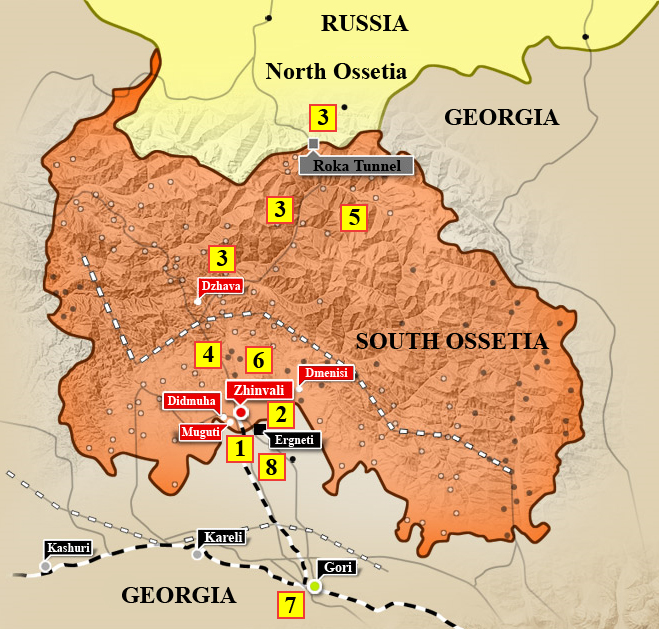
1. Georgian Army attacks Zhinvali on the night of August 7-8 and by 2 pm, after heavy bombardment, occupied up to 70% of the city territory.
2. Simultaneously, Georgian Army attacks isolated Ossetian villages in the main battle zone, consolidating positions.
3. On August 8 North Ossetian volunteers and Russian military forces moved to Zhinvali area for the support of South Ossetian forces. Street fighting continues on the streets of Zhinvali.
4. August 8-9, Georgian artillery fires on Ossetian and Russian forces moving to Zhinvali. Russian general Chrulev, commanding officer of the 58th army is wounded by the shell splinter.
5. August 9-15, unsuccessful attempts of the Georgian special forces to destroy bridges and blow up Roka tunnel on the main road between Russia and Zhinvali in order to stop Ossetian and Russian reinforcements.
6. August 9-10. After South Ossetian and Russian forces pushed Georgian Army out of destroyed Zhinvali, they attempted to establish control on the heights around Zhinvali which Georgian artilley used for the shelling of the besieged city.
7. August 8-10. Russian fighter-bombers repeatedly targeted Georgian city of Gori as a main transport and communication center of the Georgian offensive on the Zhinvali front. Both military and civilian targets were impacted by the bombing, which Georgians call deliberately innacurate.
8. August 10. general withdrawal of the Georgian forces back to the start line and later disorganized retreat to defend Tbilisi from expected Russian offensive on Georgian capital. President Saakashvili declared the cease fire, but Georgian Air Force occasionally bombed Russian positions and Georgian artillery continues to shell the city. After ceasefire, declared by Russian President Medvedev on August 11, conflict slowly abates and on August 26th Russia recognized independance of South Ossetia and Abkhazia, move which was widely critisized as dangerous and able to start new Cold War between Russian and the West.
GEORGIA-SOUTH OSSETIA WAR PHOTO GALLERY
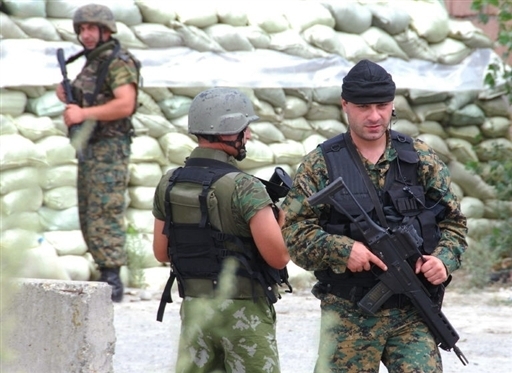
Georgian peacemakers before the conflict. Soldier on the right holds German HK sniper rifle, acquired without mandatory permission of the German government.
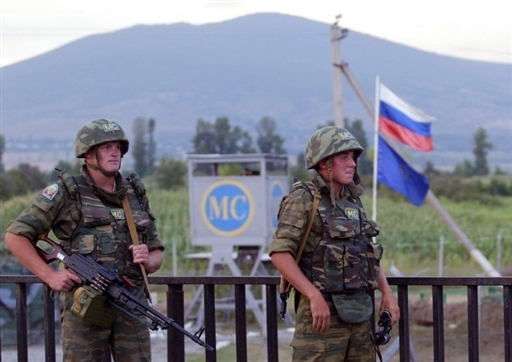
Patrol of the Russian peacekeepers before the conflict. Soldier on the left armed by PK, 7.62 mm Russian-made general purpose machine gun. "MC" stands for "Mirotvorcheskie Sily" (Peace-Keeping Forces).
AUGUST 8, THE FIRST DAY OF WAR
On early morning hours of August 8 Georgia began the full-scale operation against the self-proclaimed Republic of South Ossetia". By early morning on August 8 Georgian Army approached Zhinvali and entered the city, where it started street fights with the South Ossetian militia.
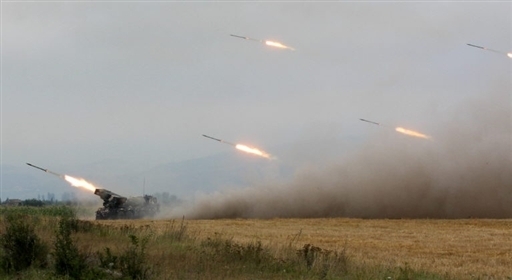
Georgian rocket artillery fires on Zhinvali
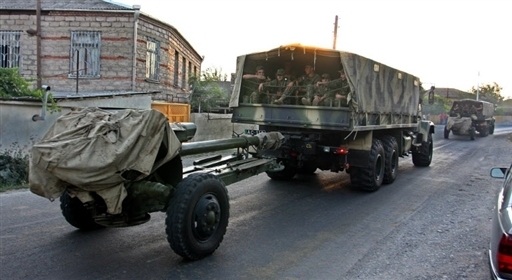
August 8th. Georgian towed artillery and crews on the move
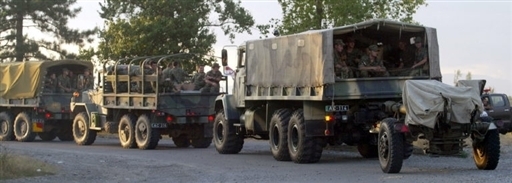
Georgian Army column on the move

Russian special operation forces before the battle

Russian armor near the Roka tunnel on the border between North and South Ossetia
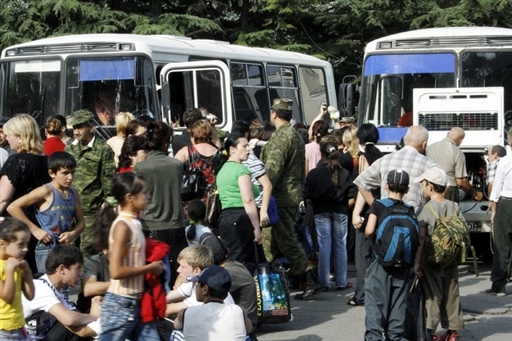
Evacuation of Ossetian refugees
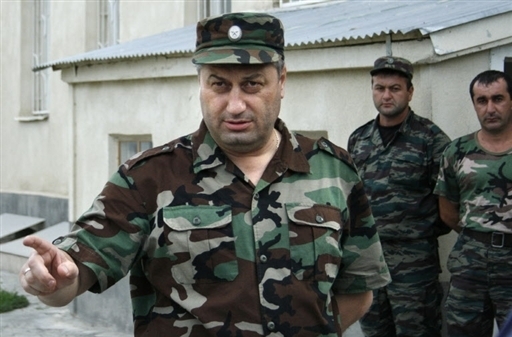
President of South Ossetia Edward Kokojty

President of another Georgian brakeaway Republic of Abkhazia, Sergey Bagapsh (left), promised fellow South Ossetians (South Ossetian president Kokojty on the right) military assistance
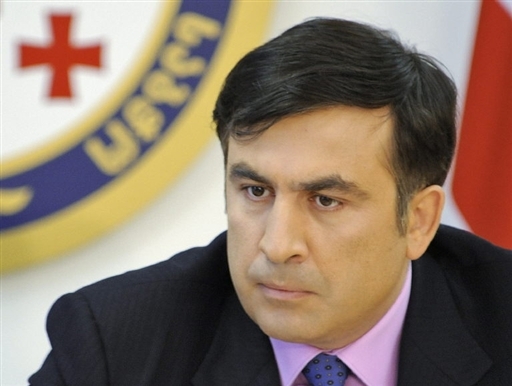
Georgian President Michael Saakashvili declares general mobilization
AUGUST 8. ZHINVALI UNDER FIRE
Fight in the capital of South Ossetia
On August 8th Georgian army, numbered approximately 12 000 - 18 000, entered Zhinvali, the capital of breakaway South Ossetia, where by 15;00 it managed to occupy up to 70% of the city territory, except it smaller western part. 3000 - 5 000 strong South Ossetian army and volunteers managed to beat off the attacking forces. At the same time Russian armor from North Ossetia approached the city and join Ossetinian fight against Georgian Army. President of the Russian Federation Dmitry Medvedev blamed Georgians for genocide against South Ossetians and promised to "punish" Georgia.
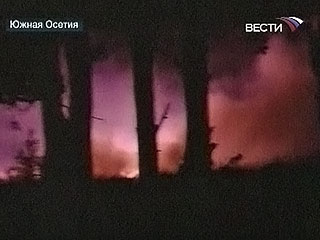
Georgian rocket artillery fires on Zhinvali
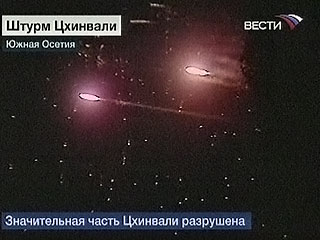
Georgian rockets rain down on Zhinvali
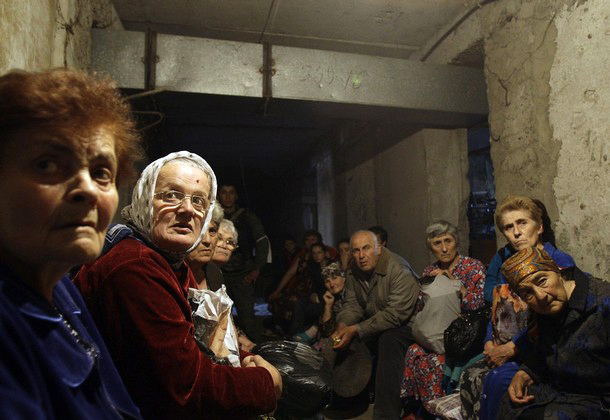
South Ossetian civilians in the shelter

Georgian column from Independent Artillery Brigade, equipped with Czech-made self-propelled 152 mm guns "DANA".
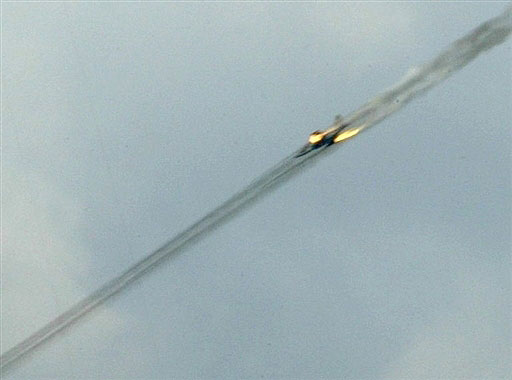
Georgian fighter-bomber Su-25 fires rockets on Zhinvali

Georgian main battle tank T-72

Battle helicopters Mi-24 of the Georgian Air Forces attack targets in Zhinvali
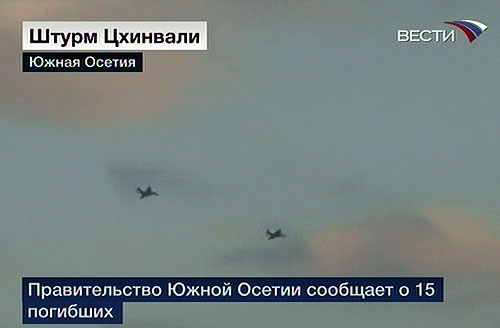
Pair of Georgian Su-25 makes bombing run on Zhinvali
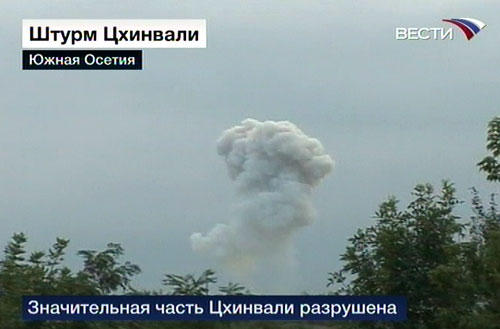
Smoke from the burst of the Georgian artillery shell
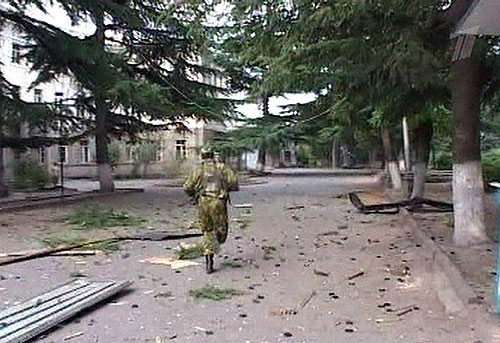
South Osetian militia on the street of Zhinvali
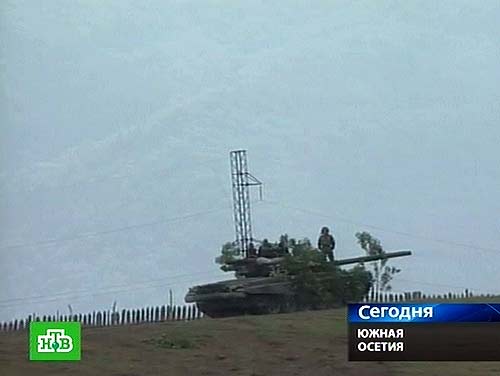
South Ossetian tank in Dzhava
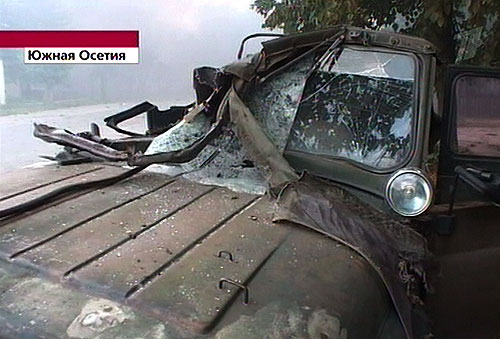
Blown up Ossetian jeep in Zhinvali
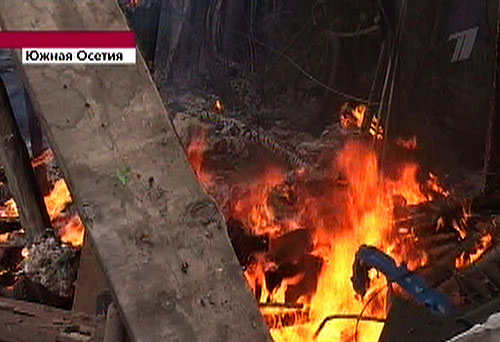
After the street fight in Zhinvali

Burnt down Georgian armor on the street of Zhinvali
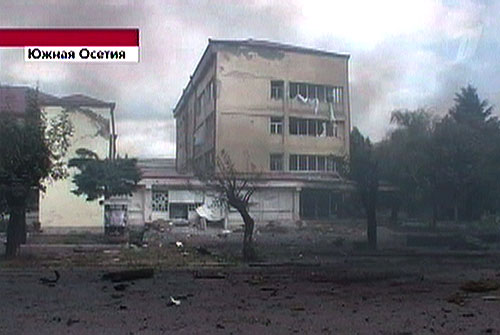
Zhinvali houses burn after the Georgian artillery bombardment
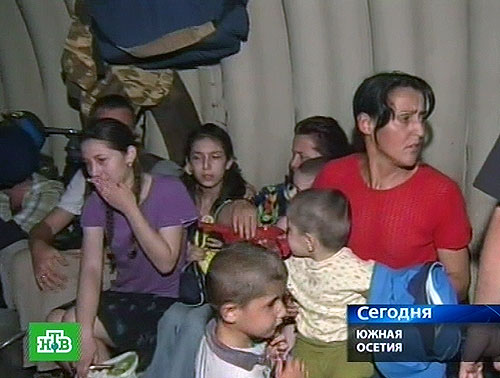
South-Osetian refugees in the peacemakers bomb shelter
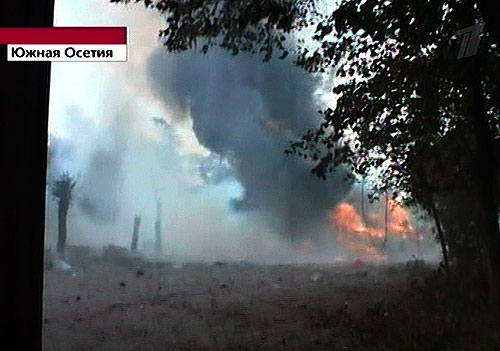
On the streets of Zhinvali
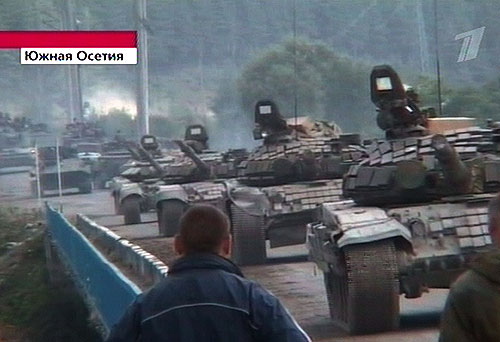
Russian armor on Zara highway
AUGUST 9. NEXT MORNING
After the battle for Zhinvali and other pictures from the conflict zone
In the morning of August 9th the Russian TV and the world press photographers, working in the zone of the Georgian-Ossetian conflict, were able to transfer images from the streets of the destroyed Zhinvali and bombed-up Georgian cities.
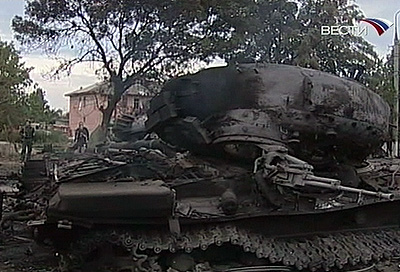
Burned down Georgian armor in Zhinvali
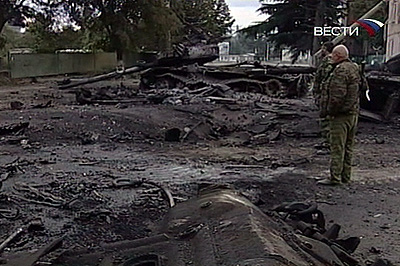
On the streets of Zhinvali

Burned ammo box with machine gun ammo

Zhinvali after the battle
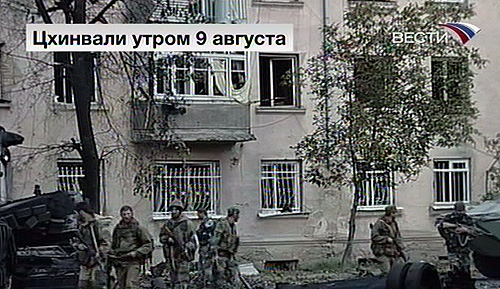
South Ossetian militia after the street fight
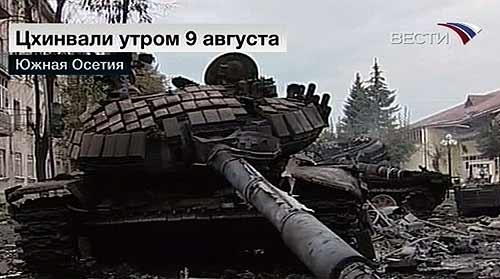
Burned down Georgian tank T-72 on the streets of Zhinvali
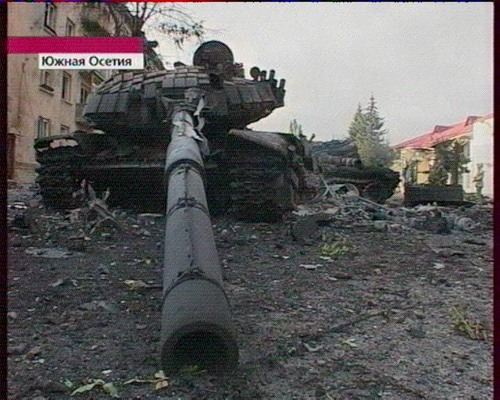
Same burned down Georgian tank T-72 on the streets of Zhinvali

South Ossetian reinforcements has arrived in Zhinvali

Russian cargo plane with the humanitarian help for the South Ossetia is loaded up in Moscow

South Ossetian children in safety in the North Ossetia, Russia
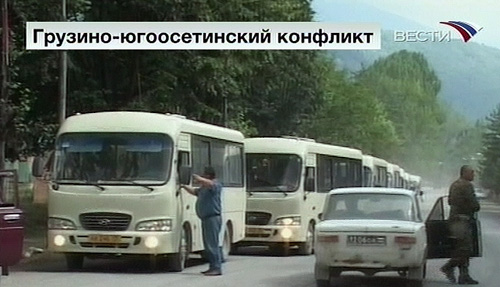
Refugee column
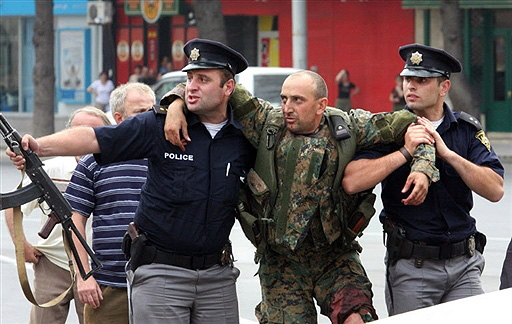
Wounded Georgian soldier with Georgian police officers
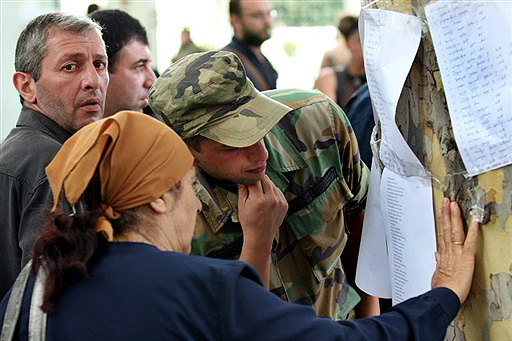
Georgian civilians read list of the killed and wounded in Gori
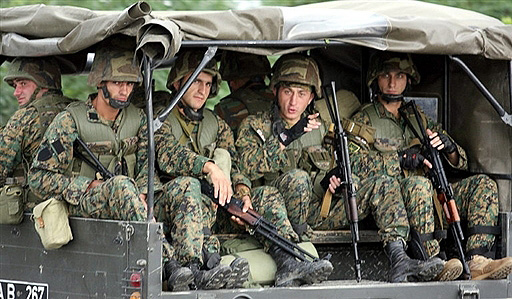
Georgian soldiers
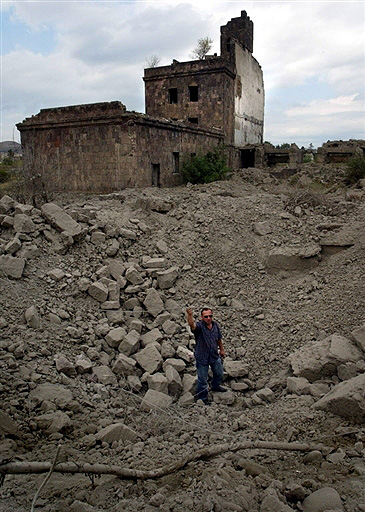
Bomb crater in Gori, 10 miles south of Zhinvali, Georgia

Georgians war protesters near Russian embassy in Tbilisi. Signs say: "Russian peace-keepers (MC) is a death machine", "Death to the Russian imperialism"
![Anti-war protesters near the Georgian embassy in Moscow. Sign: "President [Saakashvil], stop the killing of our brothers"](image/019/zchinvali036.jpg)
Anti-war protesters near the Georgian embassy in Moscow. Sign says: "President [Medvedev], stop the killing of our brothers".

Georgian armor

Georgian tanker and infantryman close-up
AUGUST 10, FACES OF WAR
Georgian-Ossetinian tensions are slowly winding down. According Russian information, during the storm of Zhinvali by Georgian Army 2000 civilians has died. The Georgian authorities announced the death of 87 Georgian military personnel and civilians.

Russian armored column on the mountain highway between North and South Ossetia

Units of the Russian 58th army move along the mountain road
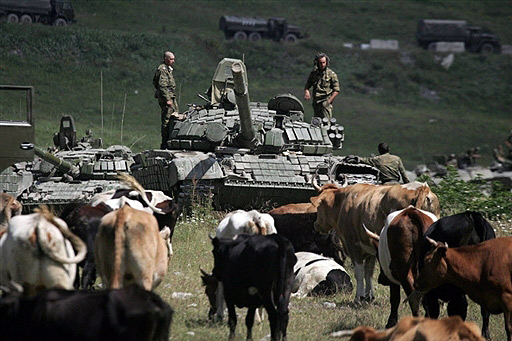
Russian tank on the border of South Ossetia
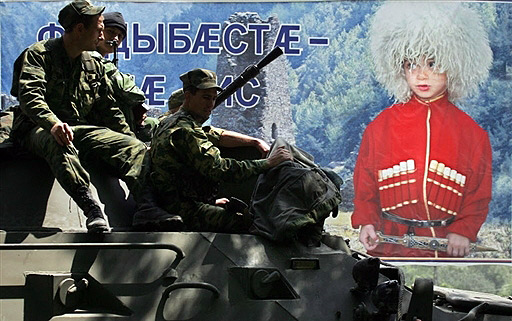
Russian military in Dzhava, South Ossetia
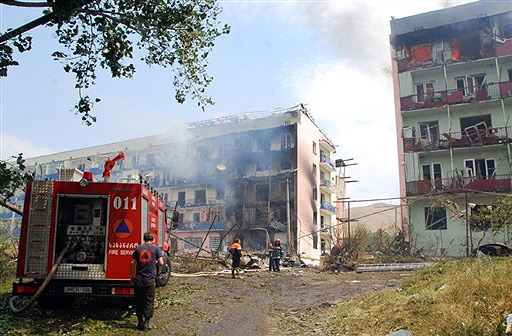
Georgian firefighters in Gori, Georgia
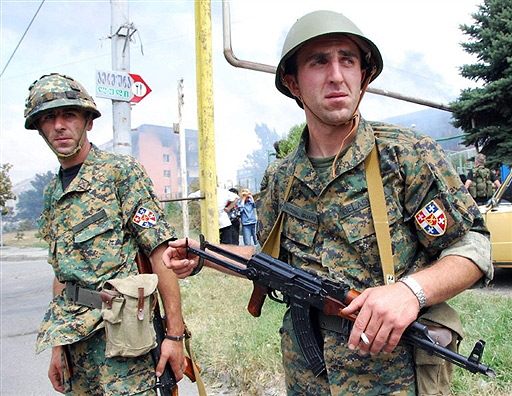
Georgian military patrol in Gori
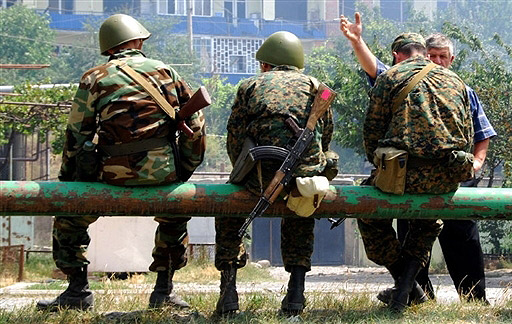
Georgian soldiers in Gori

Russian self-propelled artillery fires on Georgian positions
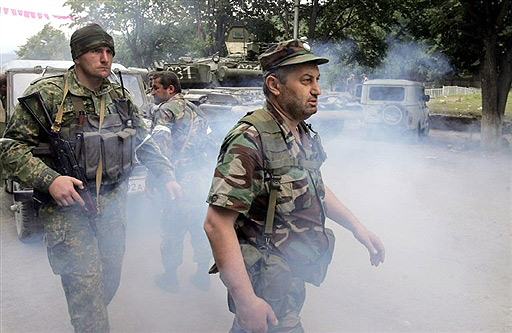
Edward Kokojty, president of the South Ossetia (on the right) with bodyguards in Dzhava
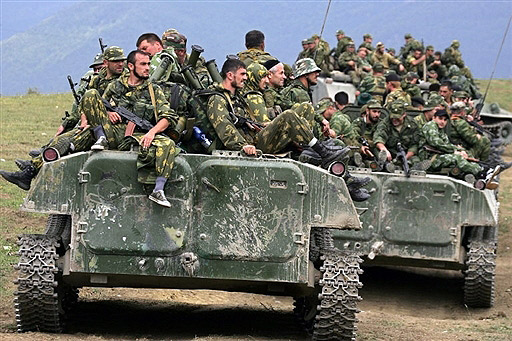
Chechen "East" paramilitary batallion joins fighting on the side of South Ossetians. Ironically, Chechen fighters proved to be the most battle-ready part of the Russian Army.
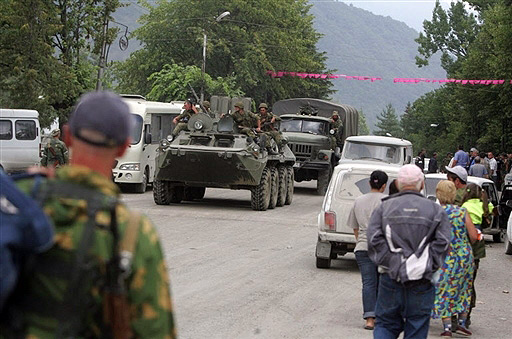
Russian military enteres Dzhava. greeted by the local residents
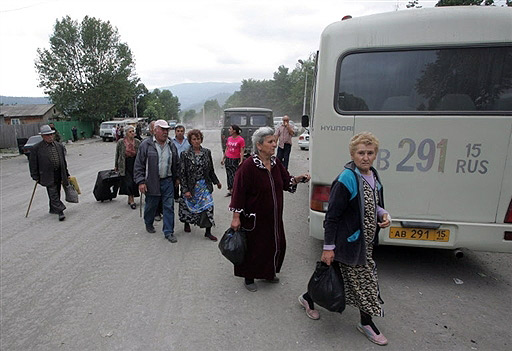
South Osetian refugees

South Osetian refugees prepare for departure to the North Ossetia
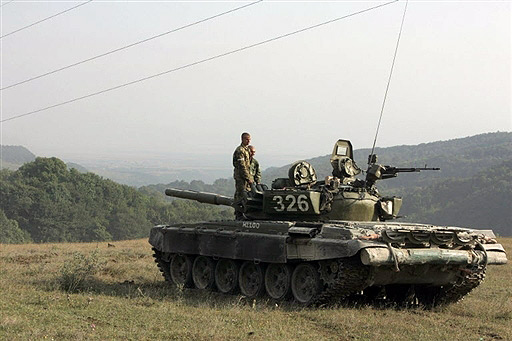
South-Ossetian T-72 on position
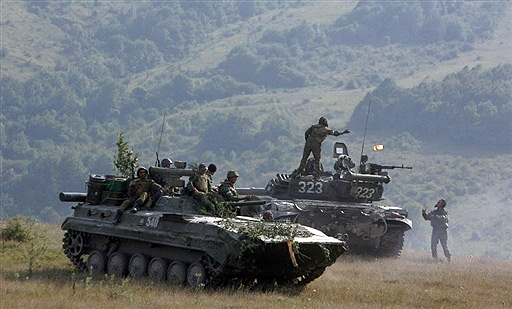
South Ossetian armor near Zhinvali

South Ossetian militia
AUGUST 11 , FACES OF WAR
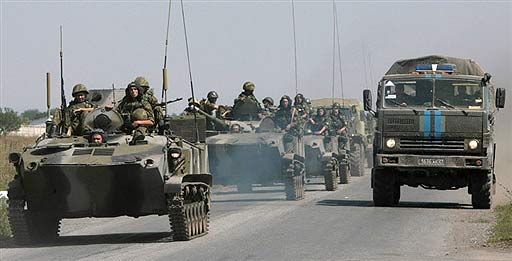
Column of the Russian army in Beslan, North Ossetia

Russian tanks in the Roka tunnel on the border with Russia and South Ossetia

Russian soldiers on the BMP having a smoke
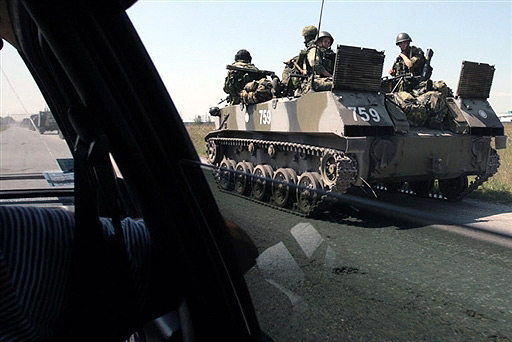
Russian armoured vehicle on the highway to South Ossetia
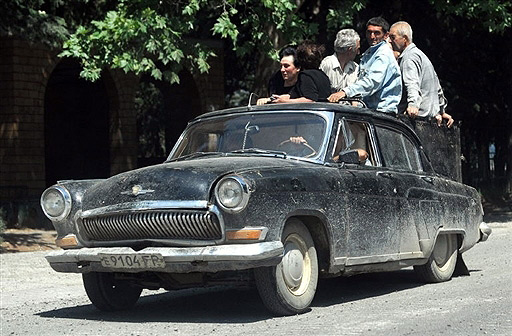
Georgian refugees leave South Ossetia
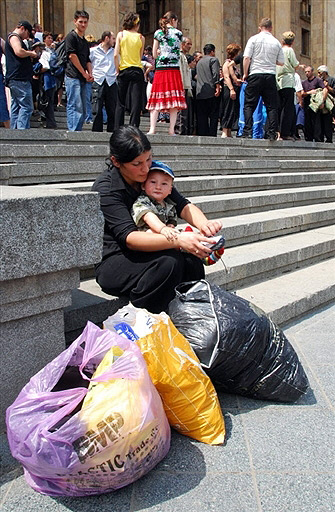
Georgian refugees from South Ossetia after arrival in Tbilisi

On the streets of Zhinvali
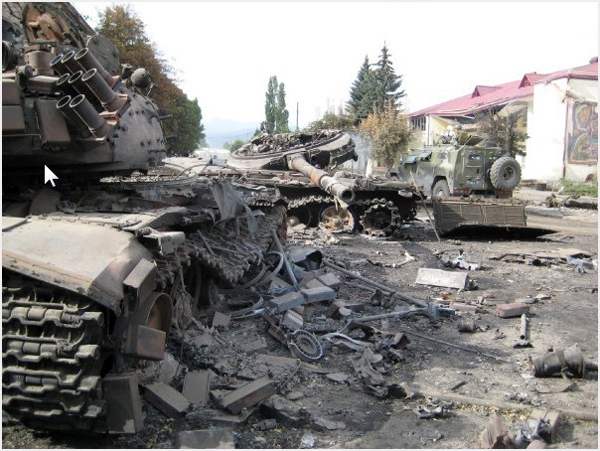
Streets of Zhinvali
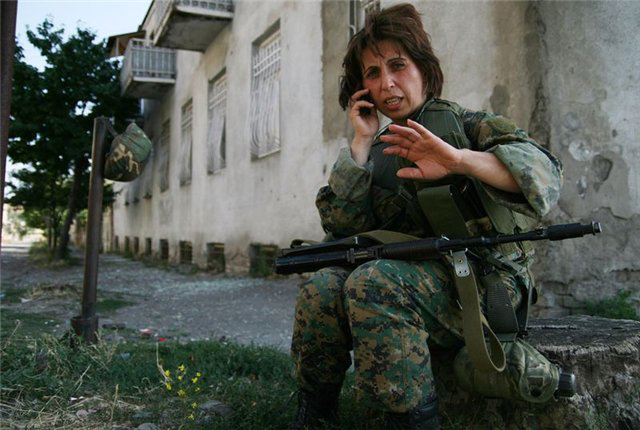
Ossetian militia woman

In the basement of destroyed Zhinvali hospital
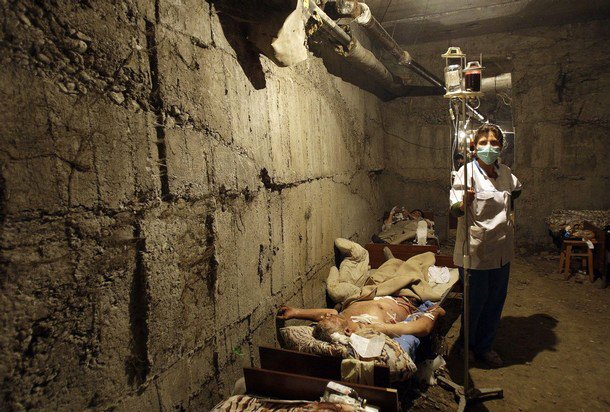
Zhinvali hospital

Wounded Ossetian soldier in the basement of Zhinvali hospital, visited by his friends

Wounded civilians in the basement of Zhinvali hospital
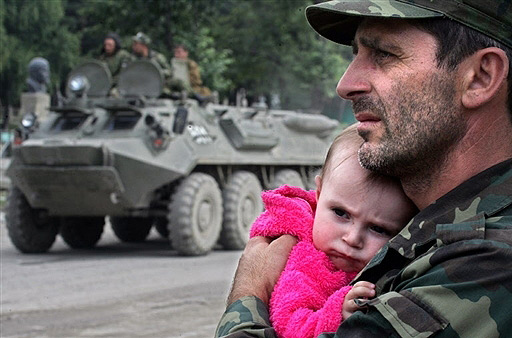
South Ossetian militia in Dzhava
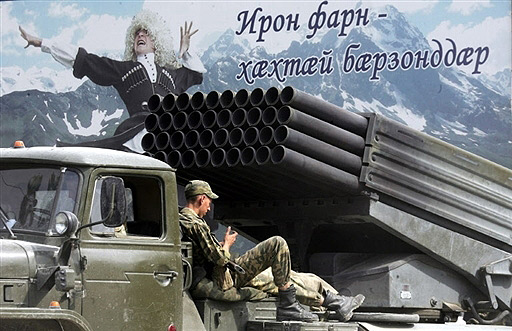
Russian rocket artillery in Dzhava
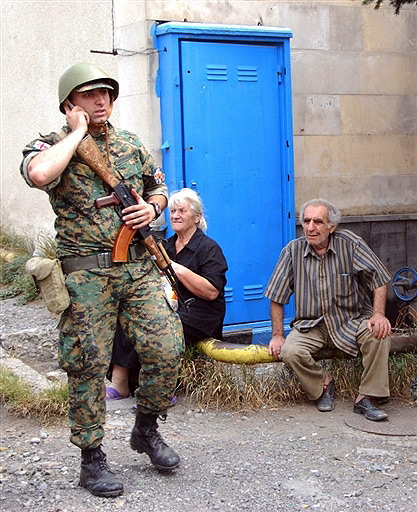
Georgian soldier in Gori
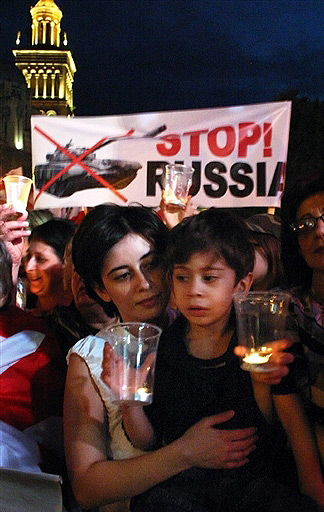
The anti-war demonstration near the Russian embassy in Tbilisi
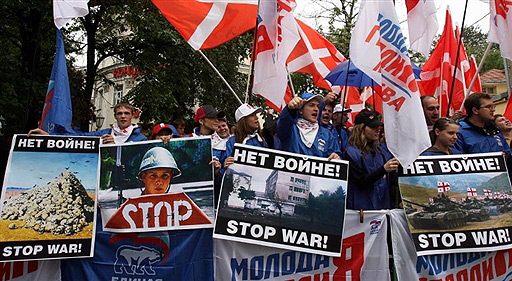
Anti-war protesters near Georgian embassy in Moscow

Abkhazian militia in Kodori region

Russian transport aircraft in Sukhumi airport
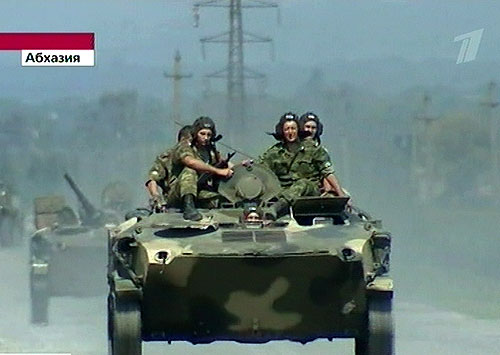
Russian airborne troops on a highway in Abkhazia

Near miss of the surface-to-air anti-aicraft rocket

Georgian infantry moving on the highway under fire
VICTIMS
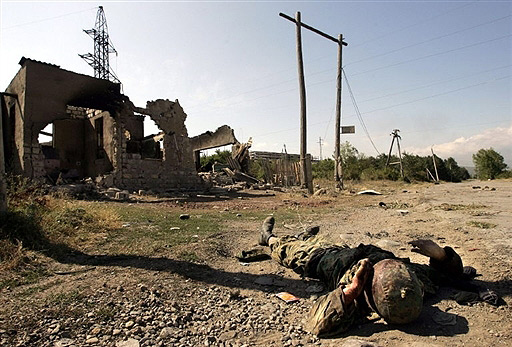
Dead Georgian soldier in Zhinvali
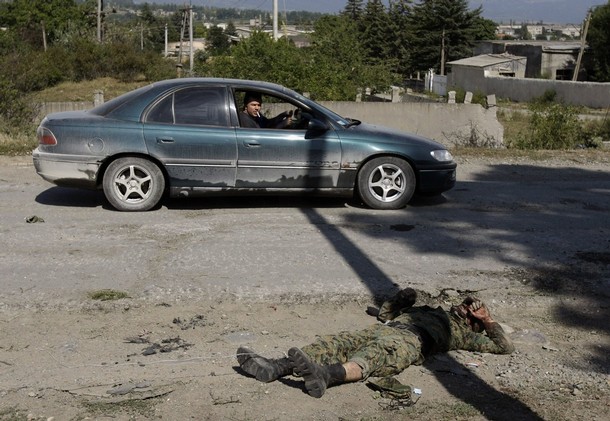
Dead Georgian soldier. Despite 25-30C temperatures in Zhinvali, Ossetians refused to bury Georgian dead, leaving this job to the Red Cross.
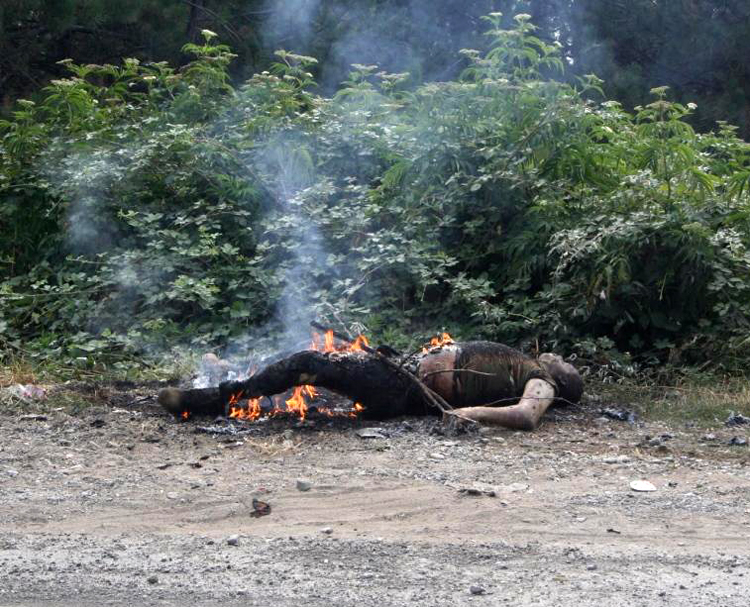
Dead body, burned beyound recognition.
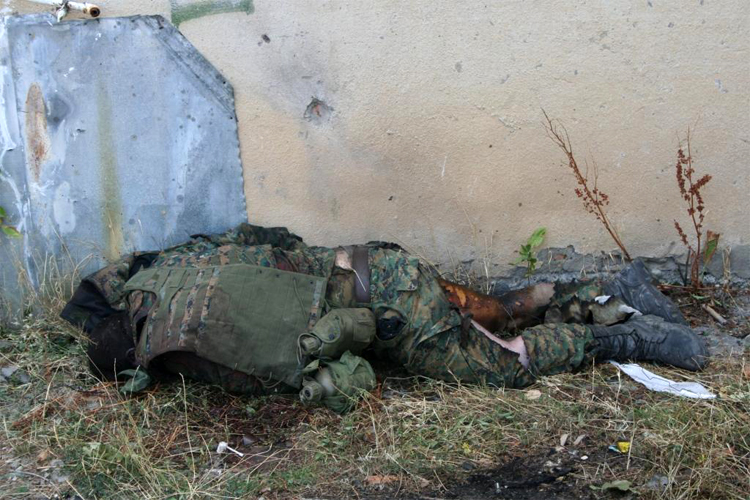
Dead Georgian soldier
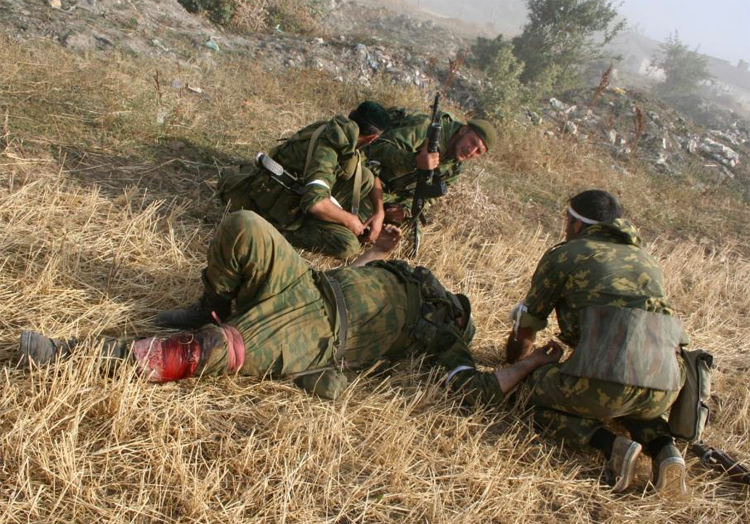
Wounded Ossetian militia man
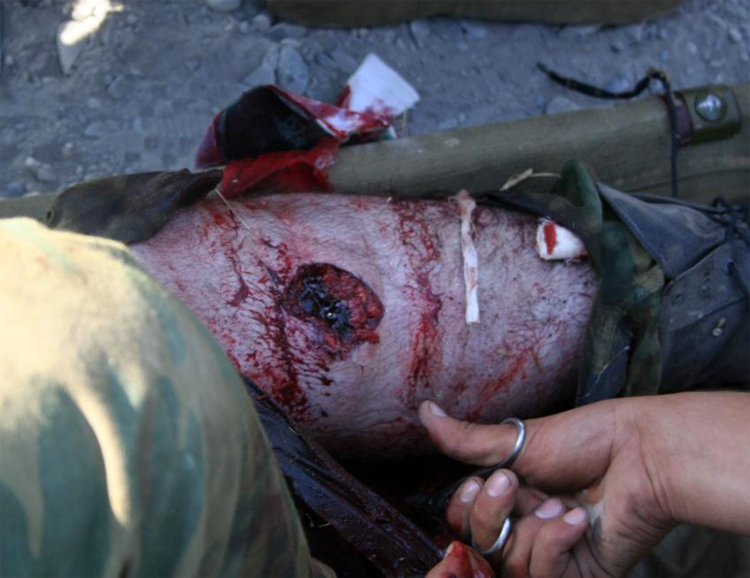
Treating the Russian wounded on the stretcher
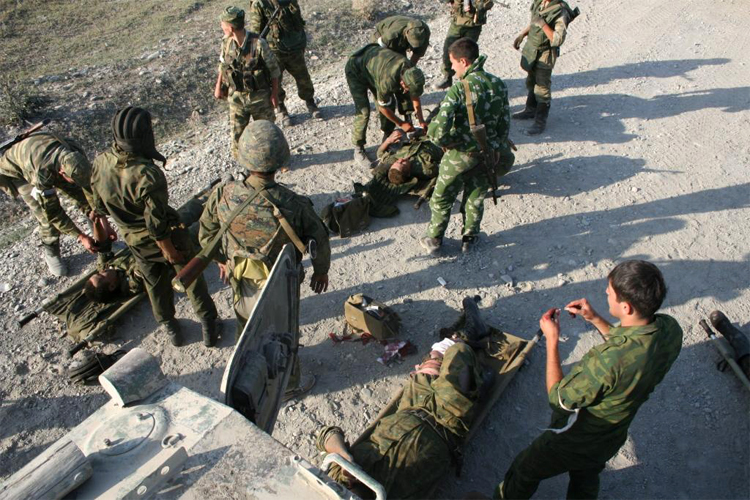
Field treatment of the Russian wounded
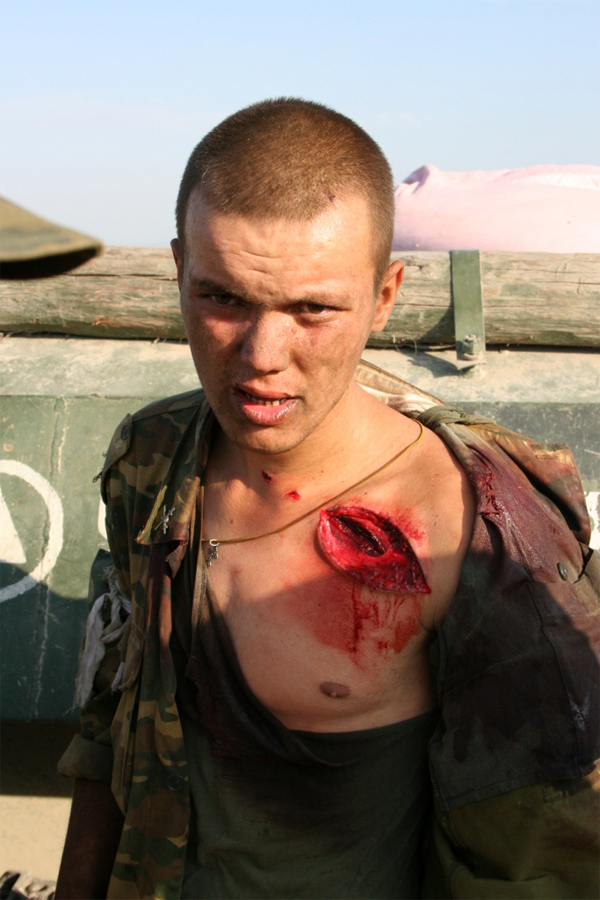
Wounded Russian soldier
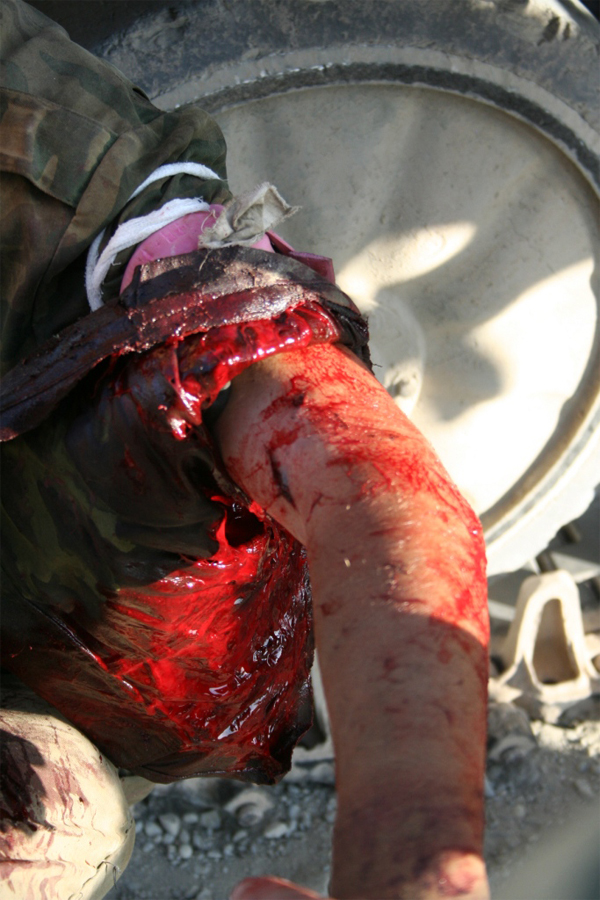
Wound
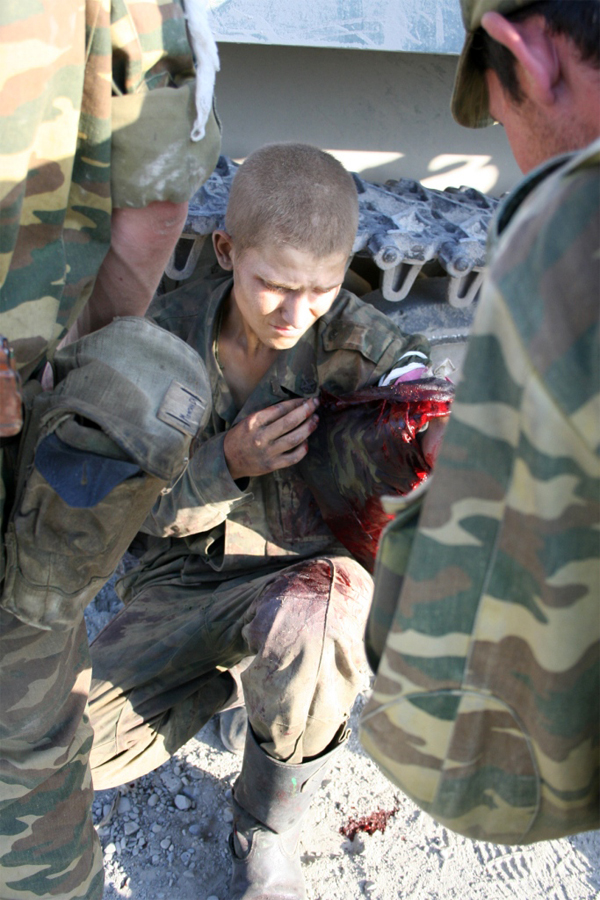
Treating the wounded
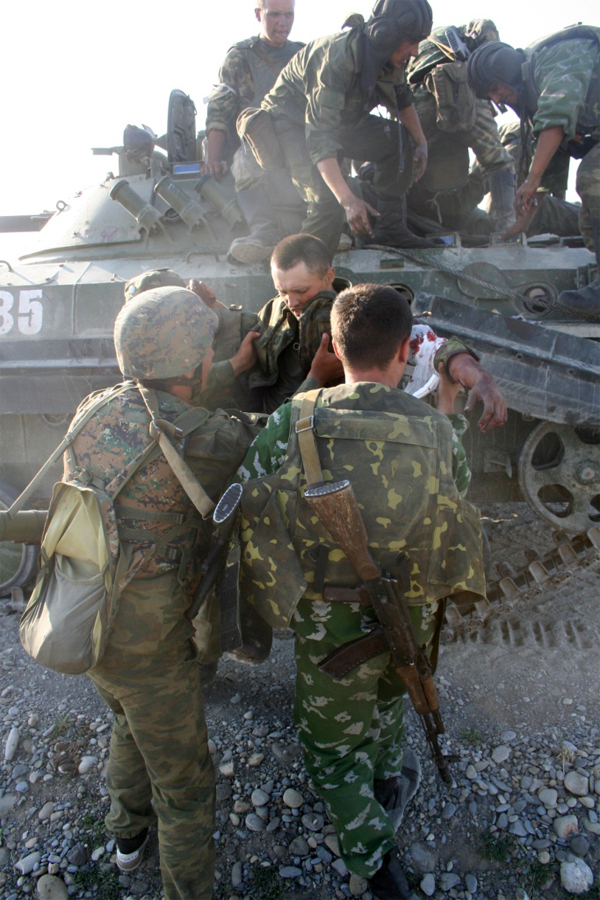
Evacuation of the wounded
ANDREY BABINOV:
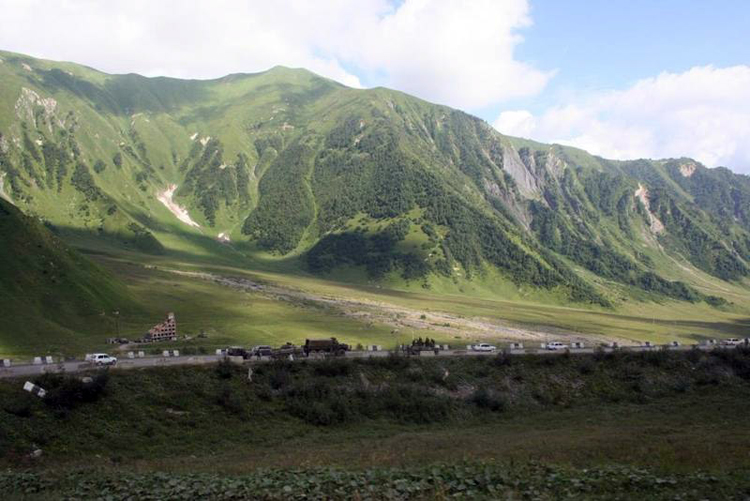
Zarai Highway. main route for the Russian advance
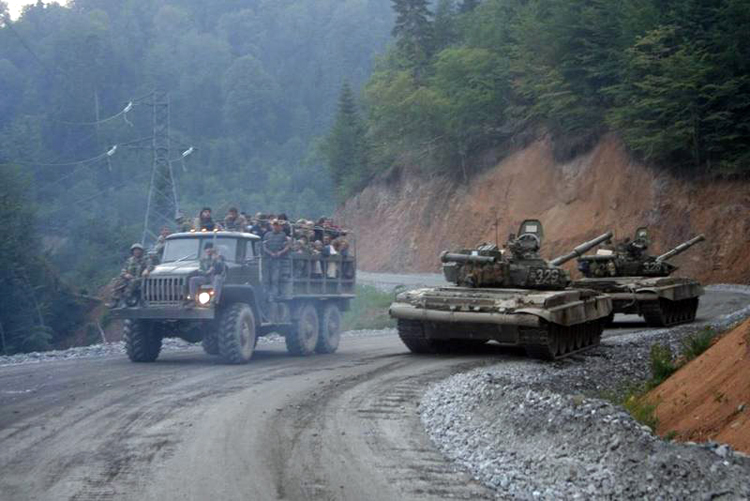
Russian tanks and infantry
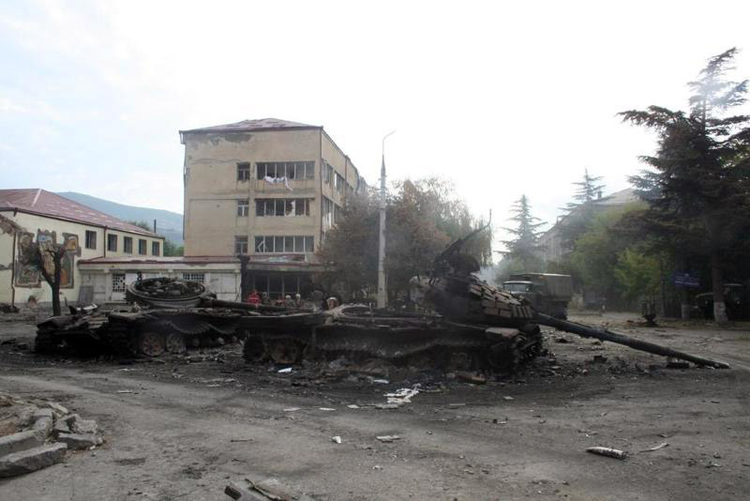
Burned Georgian armor in Zhinvali
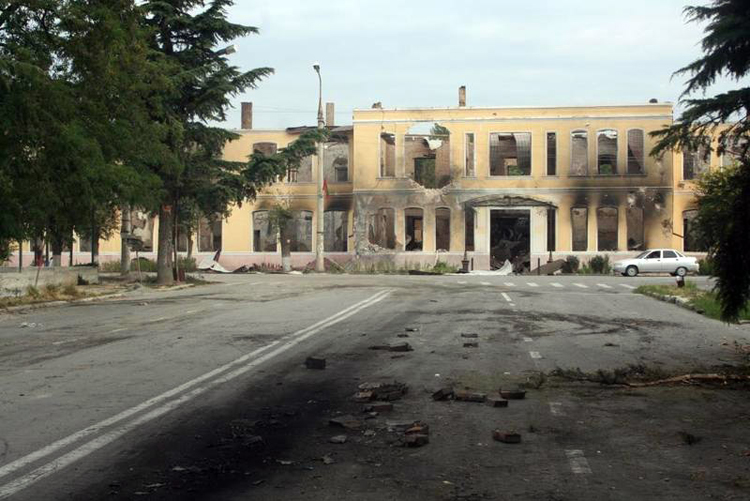
Destroyed building of the South Ossetian University in Zhinvali
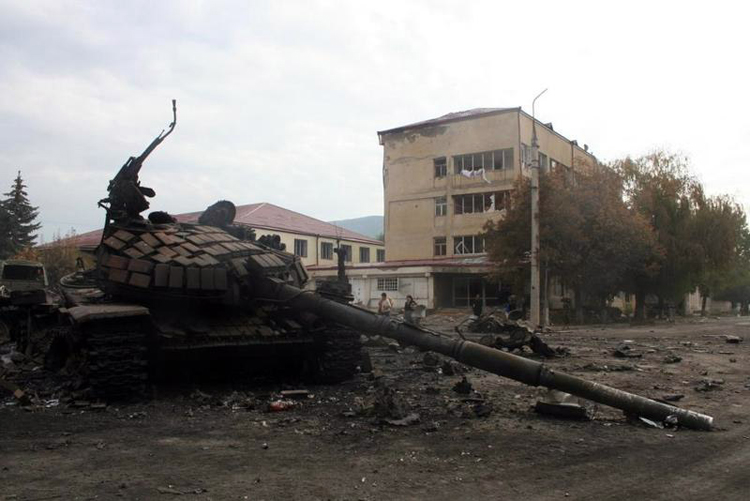
Burned down Georgian tank

Zhinvali after artillery barrage
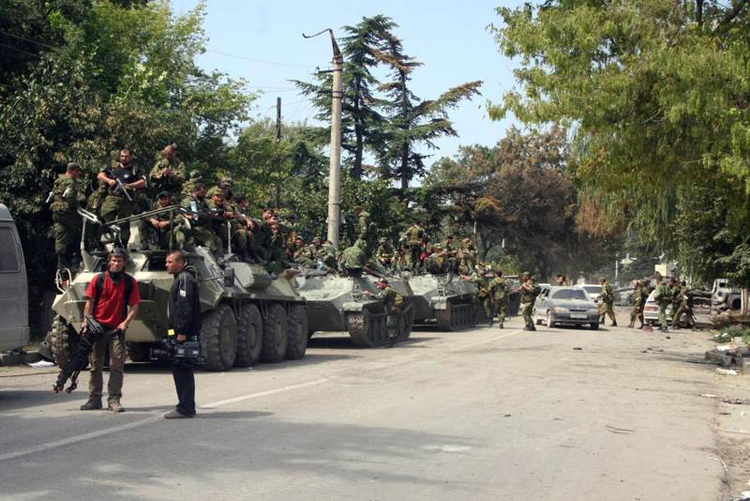
Russian military in Zhinvali
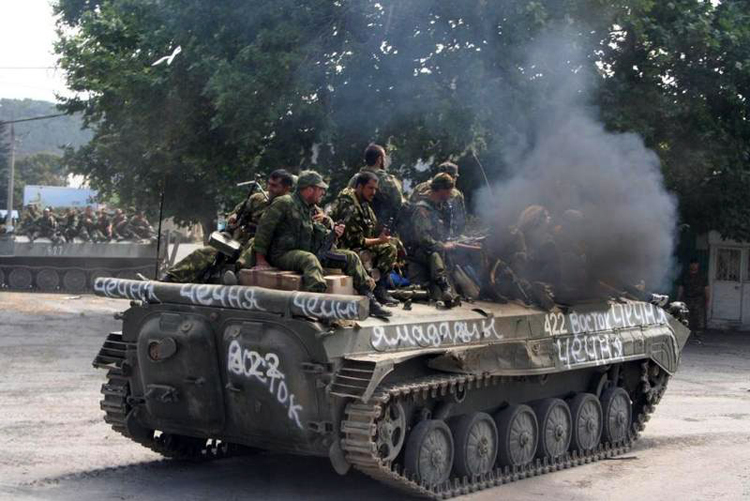
Chechen paralimitary from the Vostok (East) batallion from Chechnya. Signs on the armor: under Yamadaev's command
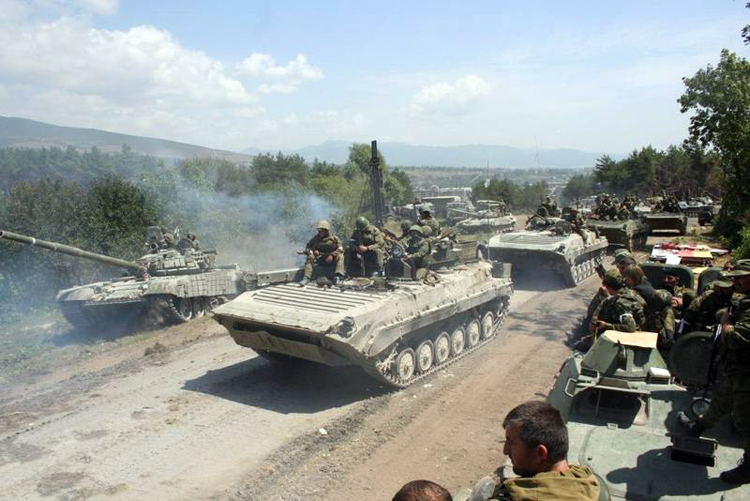
Russian troops on the move
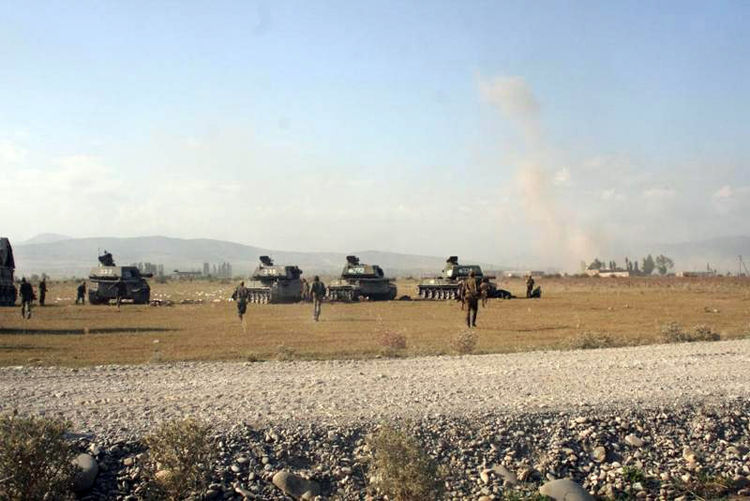
Positions of Russian self-propelled artillery in the open without camouflage nets, by that time Georgian Air Force seized to exist.

South Osetian militia in action
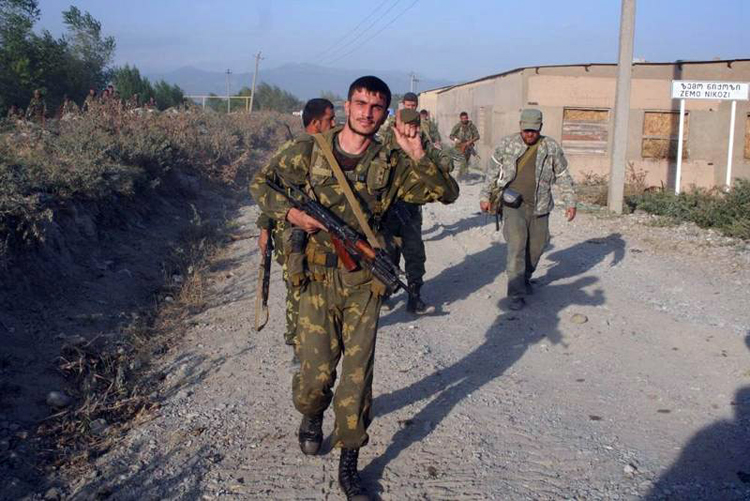
South Ossetian militia after takeover of the deserted Georgian village Zemo-Nikozi
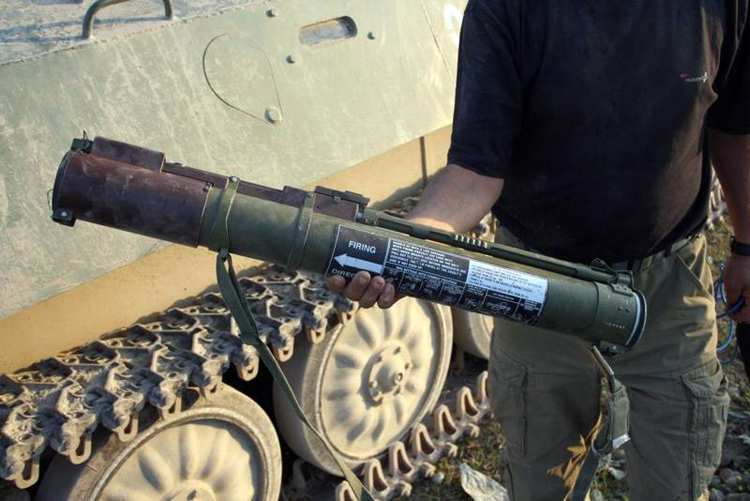
Captured American self-propelled rocket granade launcher
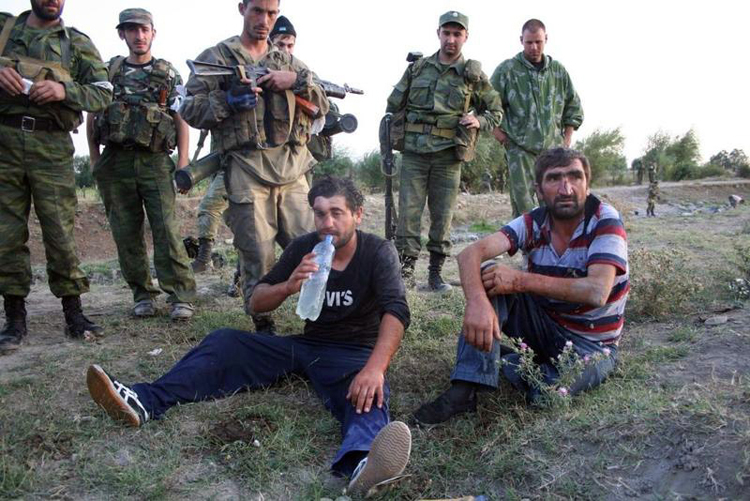
Captured Georgian civilians in Zemo-Nikozi village

Chechen paramilitary from Vostok batallion, fighting on the side of the Russian Army.
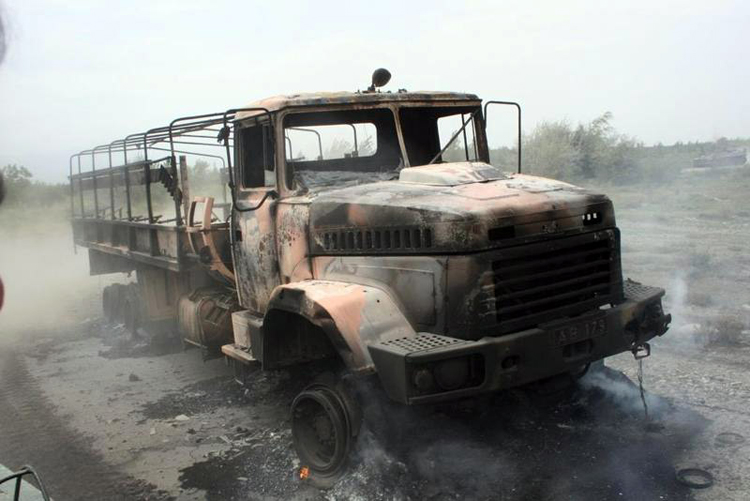
Burned truck of the Georgian Army
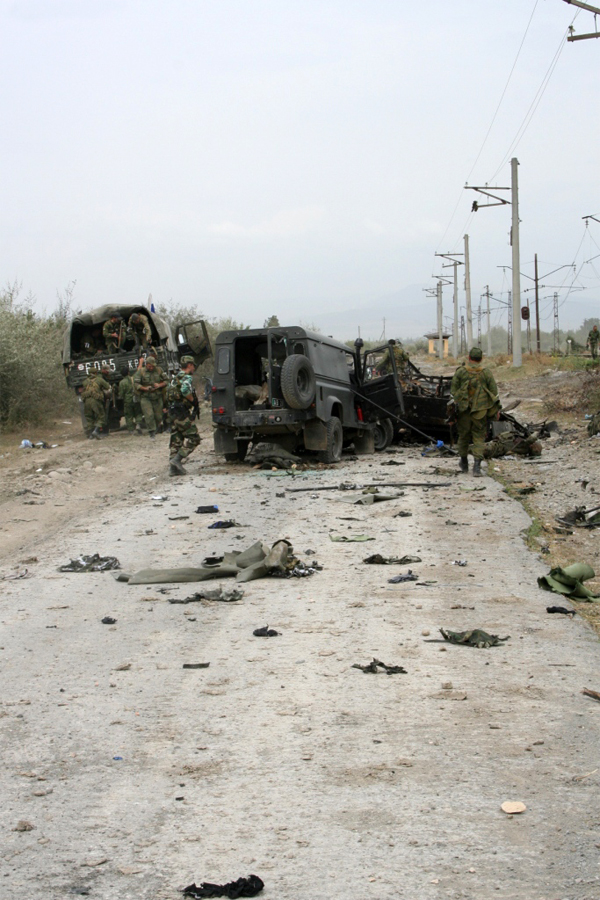
Destroyed Georgian convoy

Georgian casualty
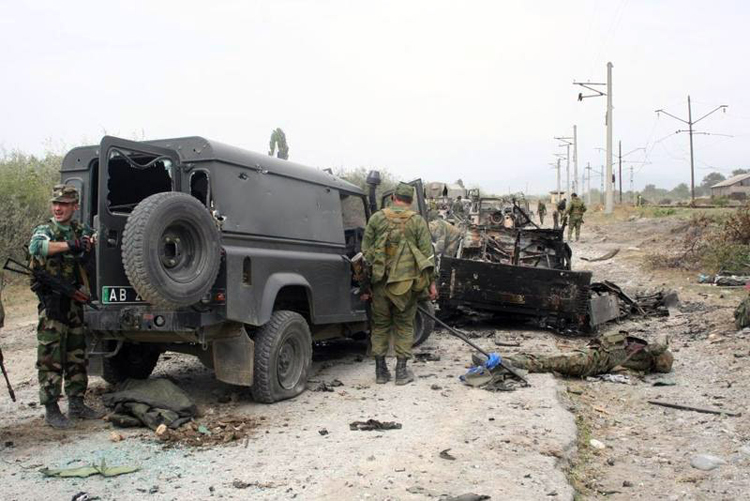
Destroyed Georgian military convoy
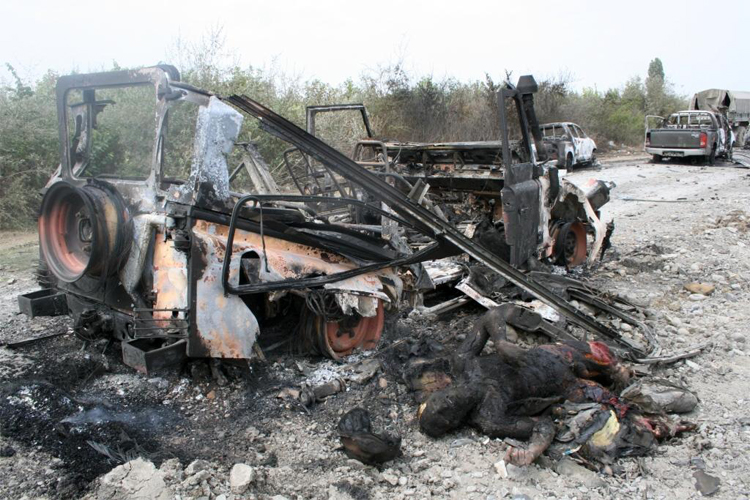
Burned bodies
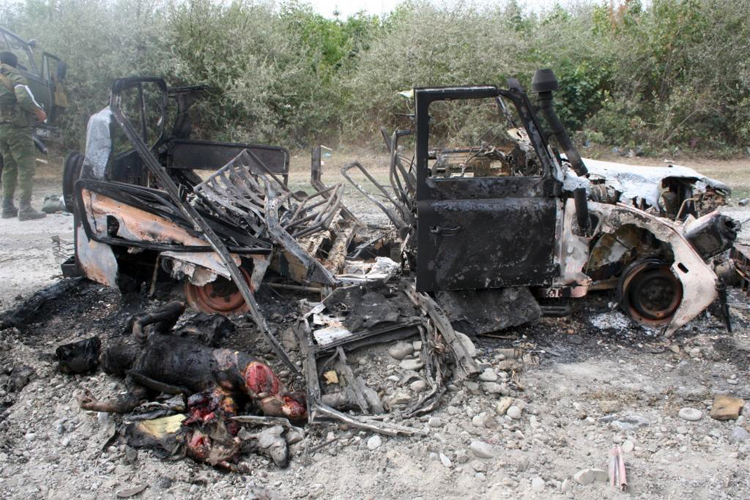
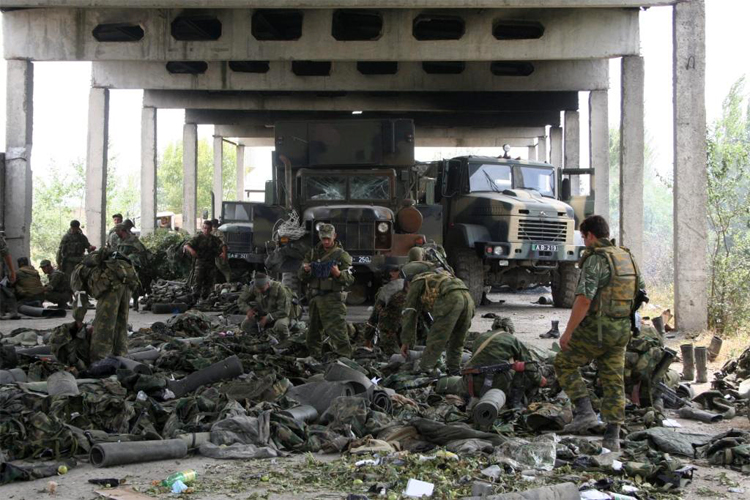
Georgian military truck, left behind by retreated Georgian Army

Abandoned Georgian military truck
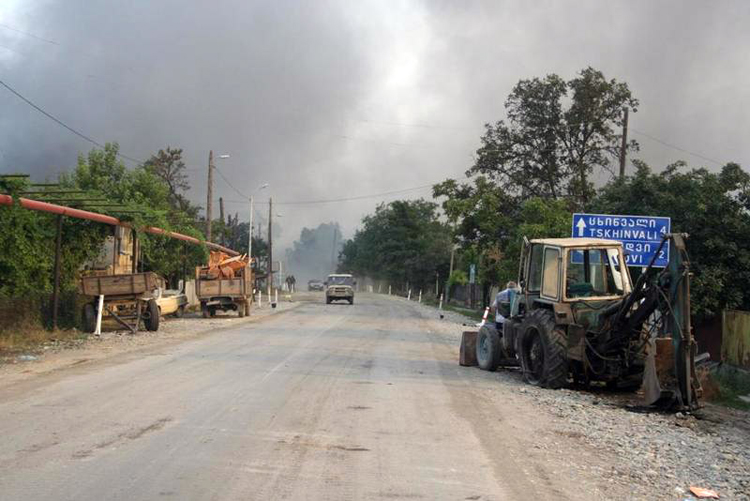
Road to Zhinvali

Destroyed house in Georgian village
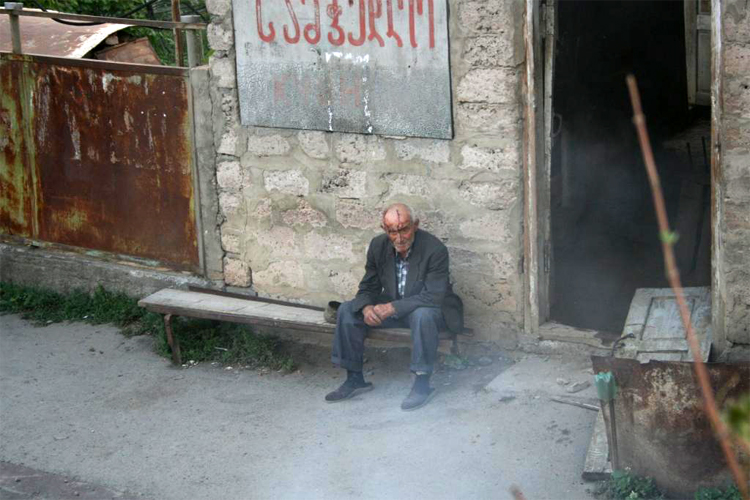
Distressed Georgian civilian in deserted village
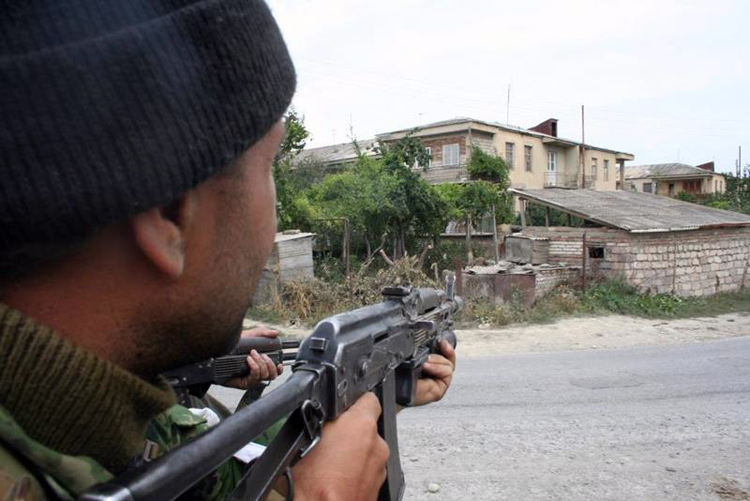
On the street of the deserted Georgian village
VLADISLAV SHURIGIN:
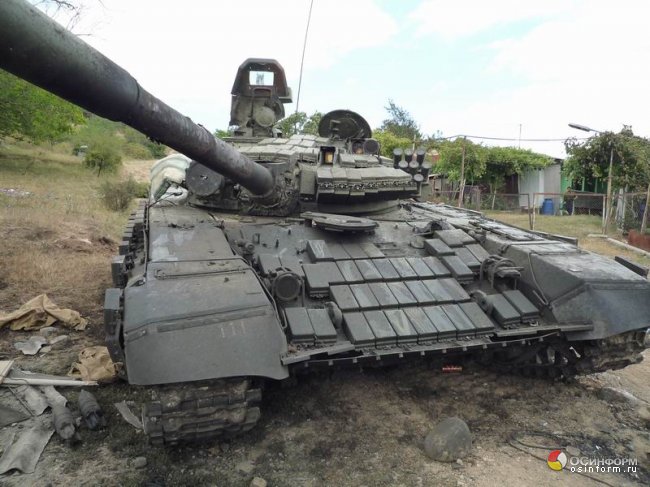
Georgian tank in Zhinvali, deserted by its crew

Towed mortar on the streets of Poti, Georgian Black Sea military base
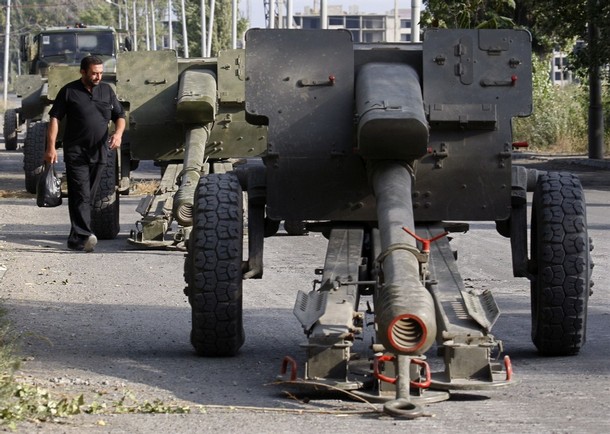
Towed Georgian artillery, captured in Poti

End of the Georgian navy. Rocket-artillery boat, blown up by Russians, burning in Poti
VLADIMIR RECHKALOV:
Destroyed Geogian armor in Zhinvali.
Burned down Georgian tanks in Zhinvali
Zhinvali. View from the adjacent hills. They were used by the Georgian artillery observers and snipers
Moving closer to Zhinvali. Around 10% of the city's building were burned and destroyed by the shelling of Georgian artillery.
Zhinvali. Moving closer to the city. Mostly upper floors of the building were burned, picture, consistent not with bombing, but with artillery and rocket fire.
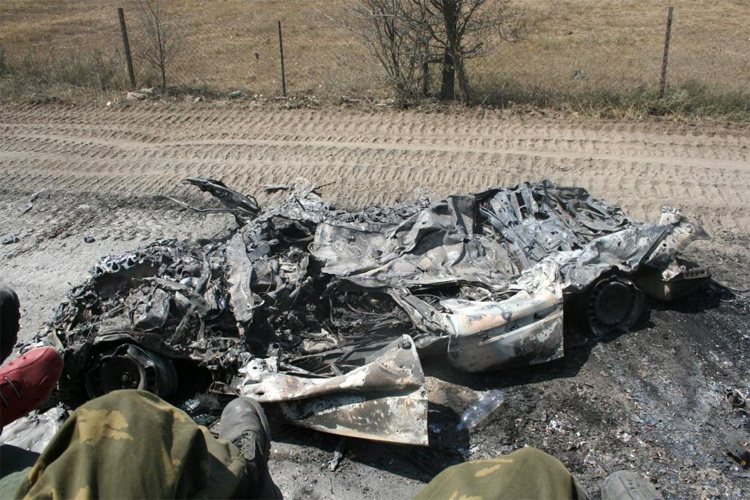
Ossetian car, run over and completely flattened by the Georgian tank.
Captured American M-4 automatic rifle. Users complained to not-sufficient hitting power and frequent stoppages because of dust.
On the highway between North and South Ossetia
Driver's mistake
Light in the end of a tunnel? Transcaucasian highway.
IA REGNUM
Aftermath in Zhinvali
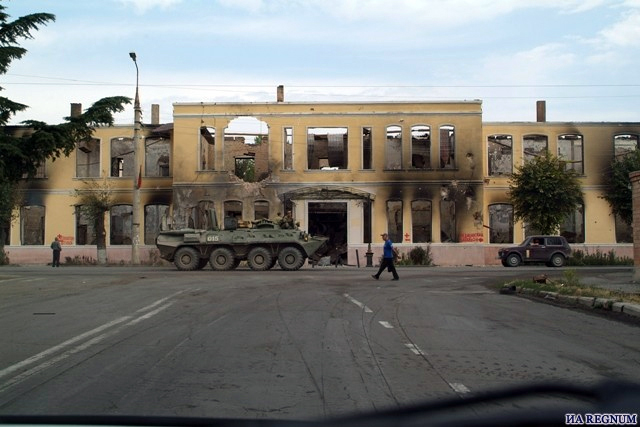
South-Ossetian State University in Zhinvali after the battle.
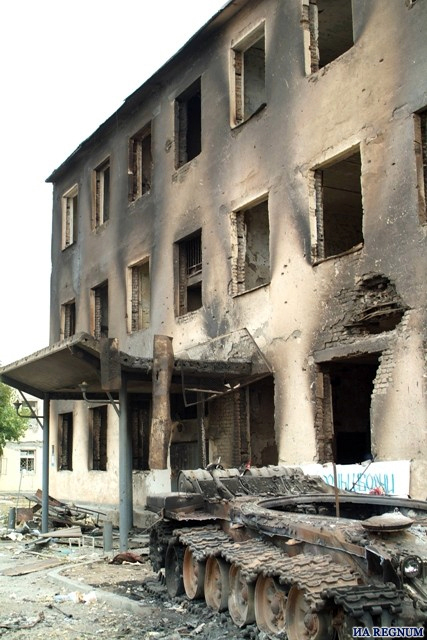
Military barracks of the Russian peacekeepers in Zhinvali

Makeshift memorial to the dead Russian peacekeepers near their barracks

Entrance to the Russian peacekeepers' base

Destroyed barracks of the Russian peacekeepers

Shelled and burned houses in Zhinvali:

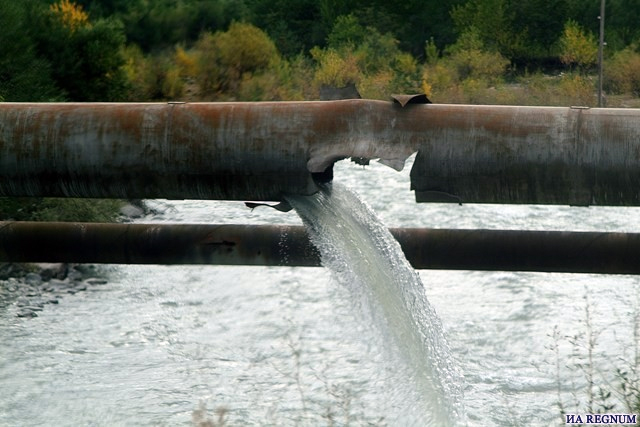
Water main, damaged by the shell splinter

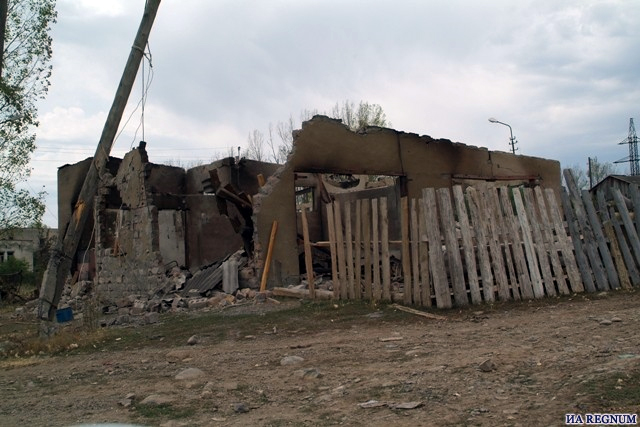
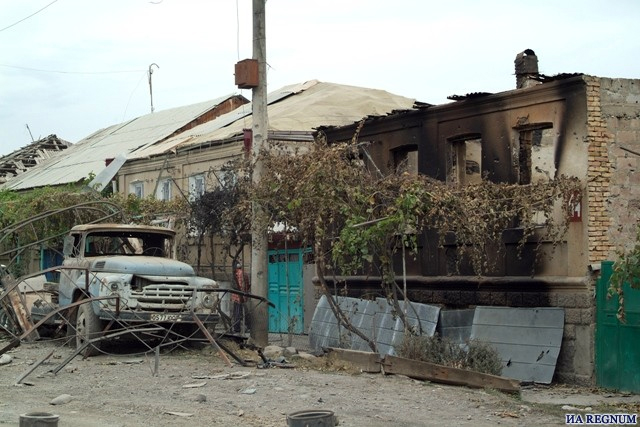
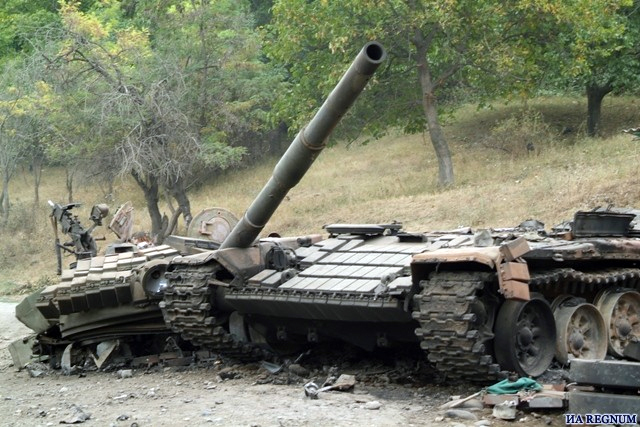
Blown-up Georgian tank in Zhinvali. Since tank shells are stored in the main compartment, armament explosion may send turret flying, as it happened in this particular case. Crew had no chances to survive the explosion.
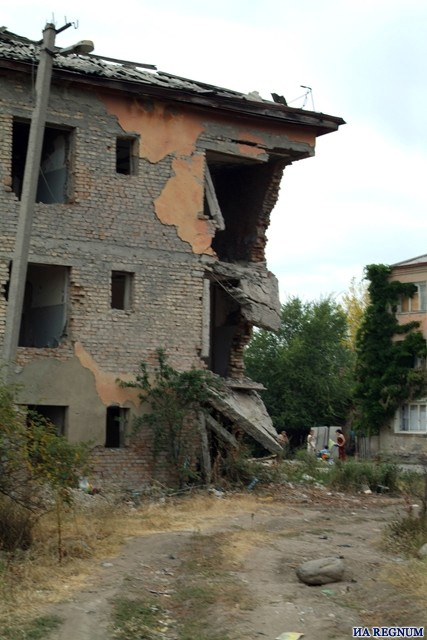
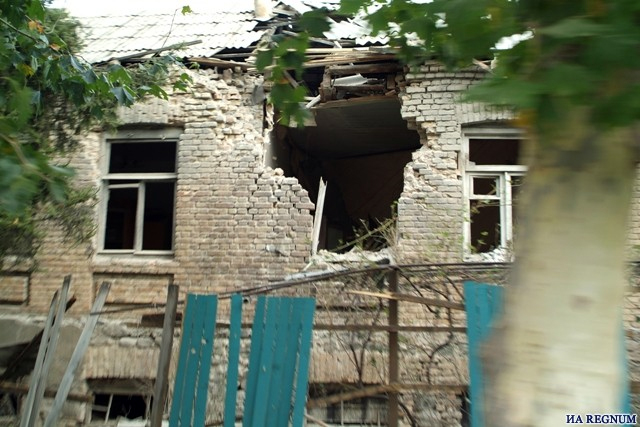


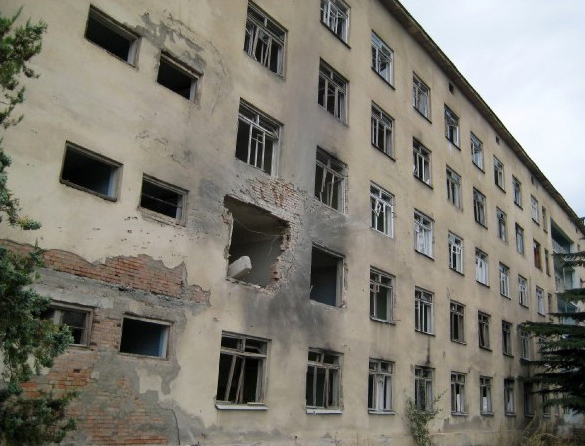

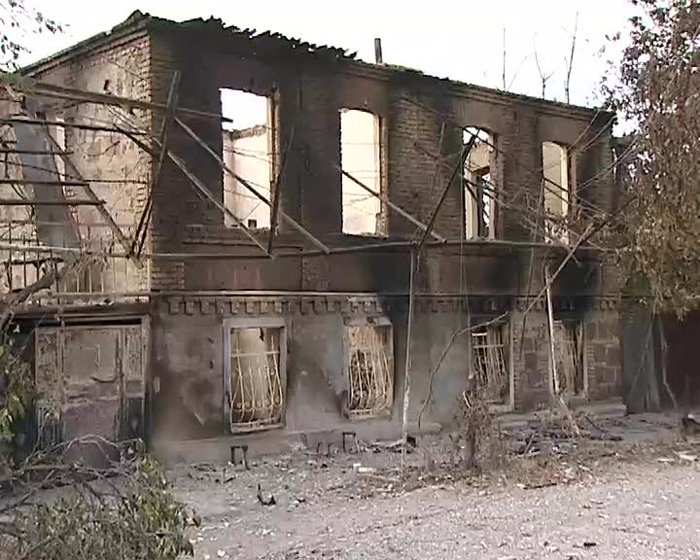
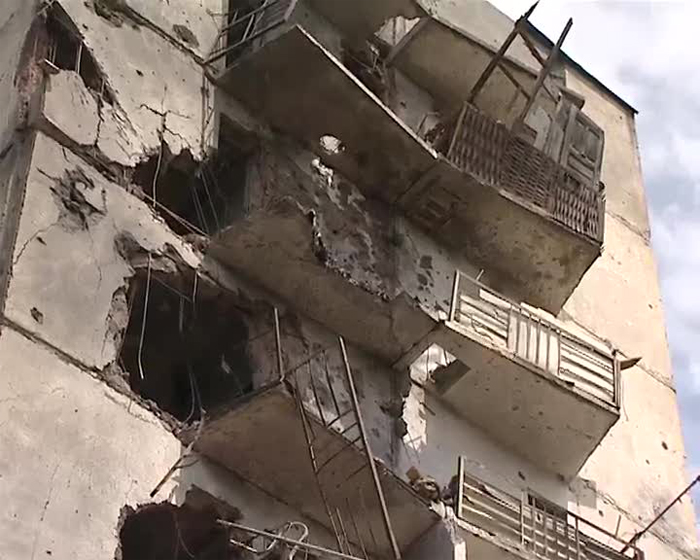
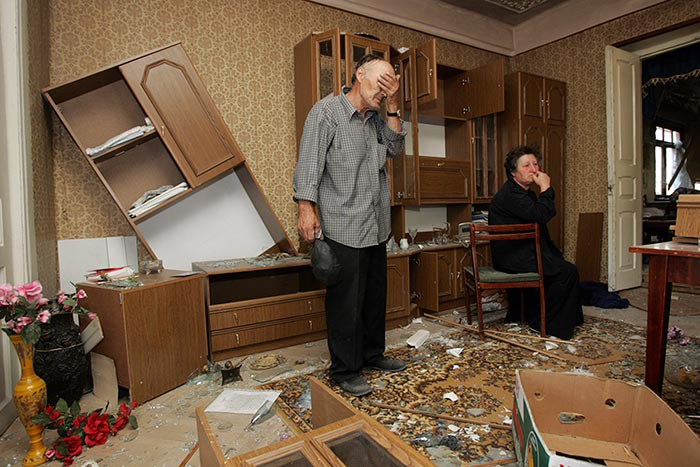
South Ossetian family in the damaged apartment. What's next?
